
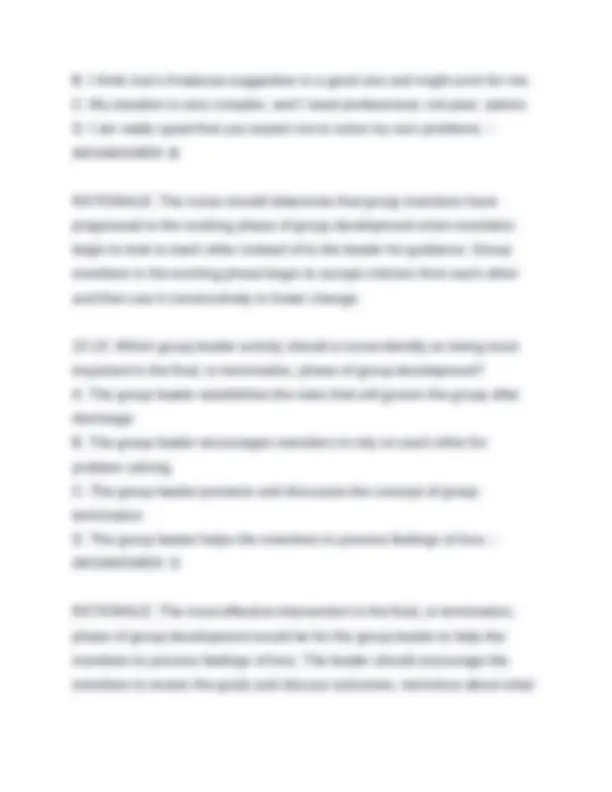
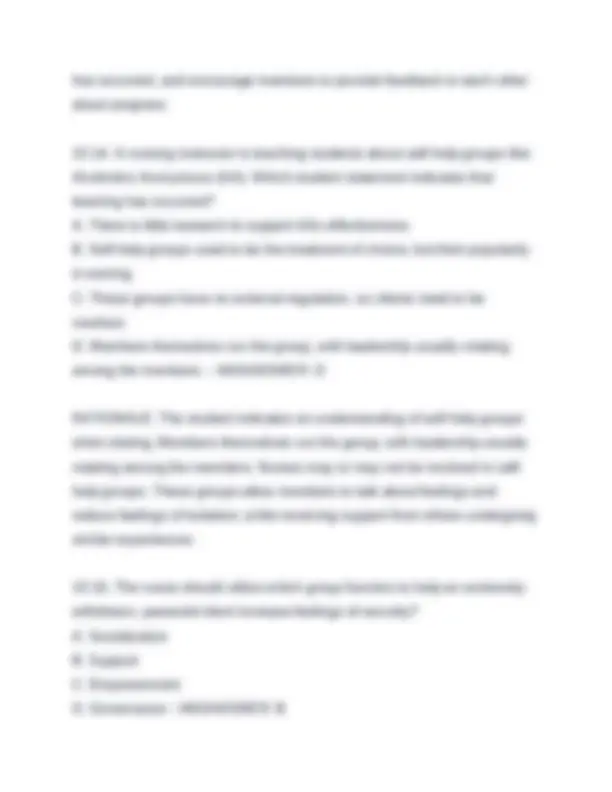
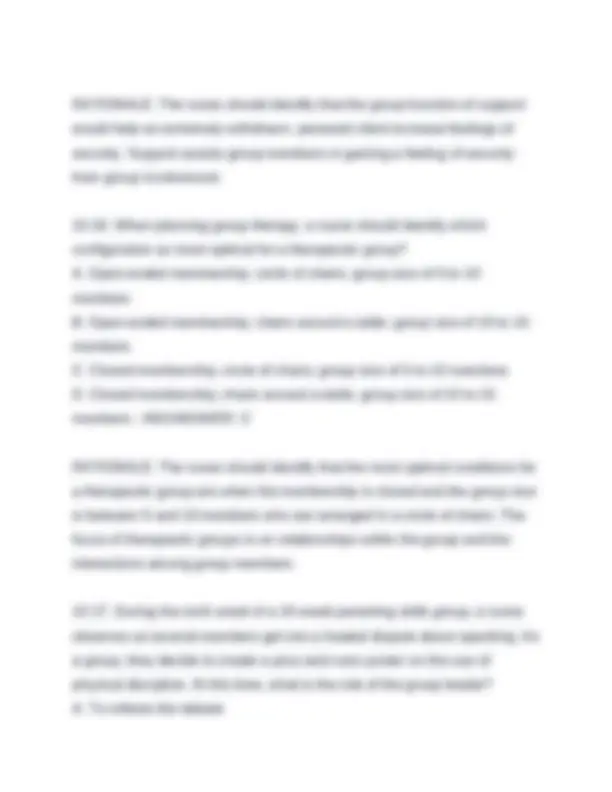
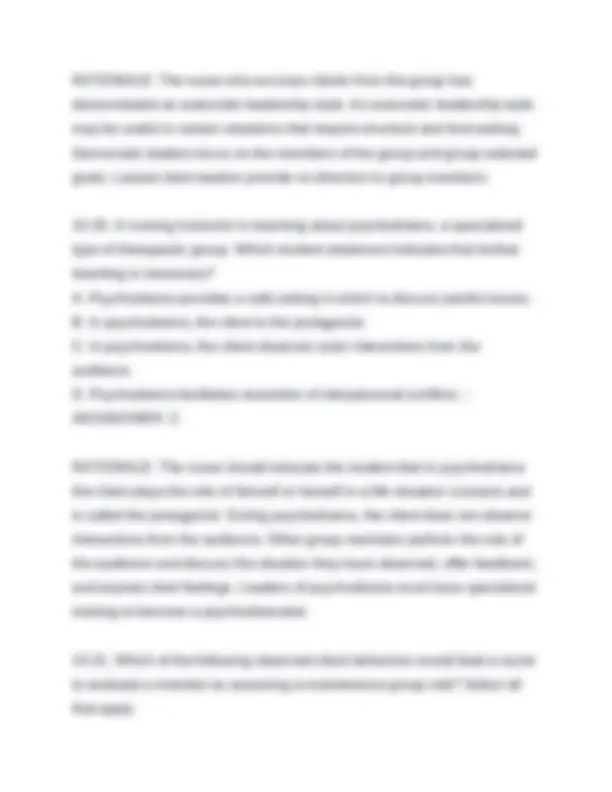
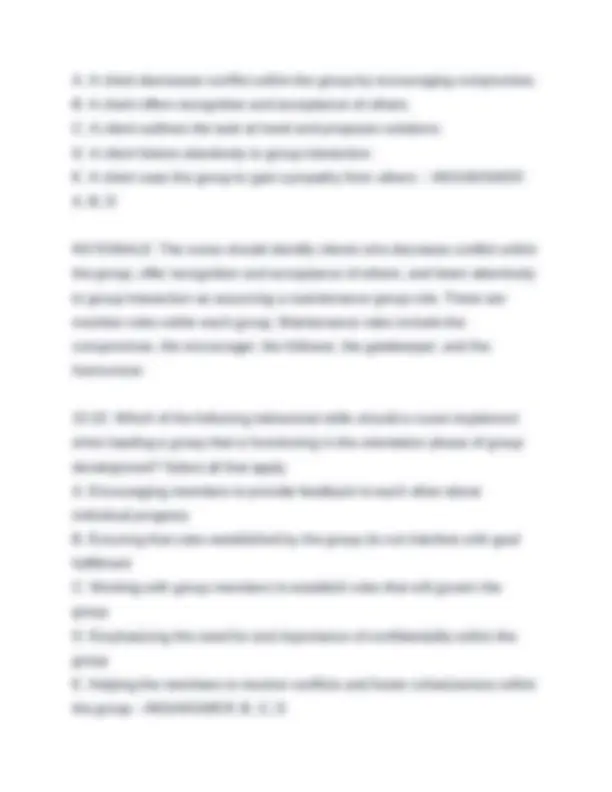
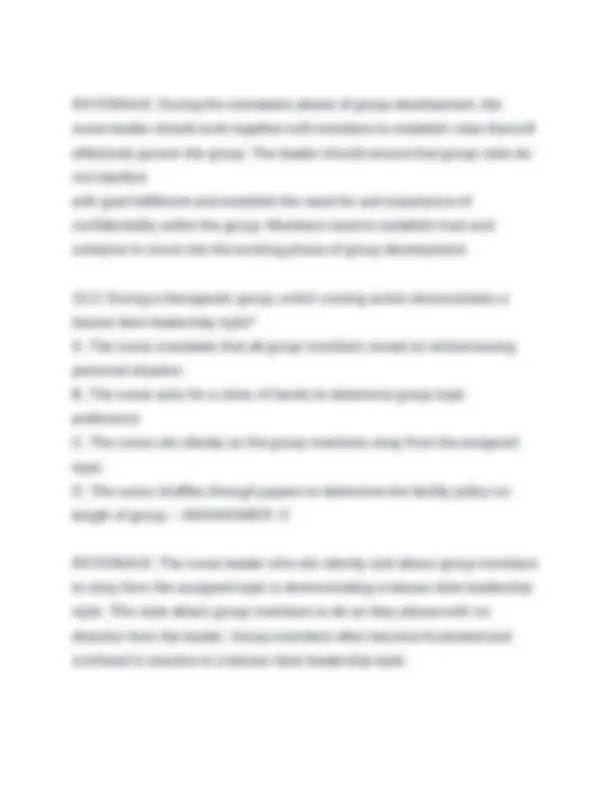
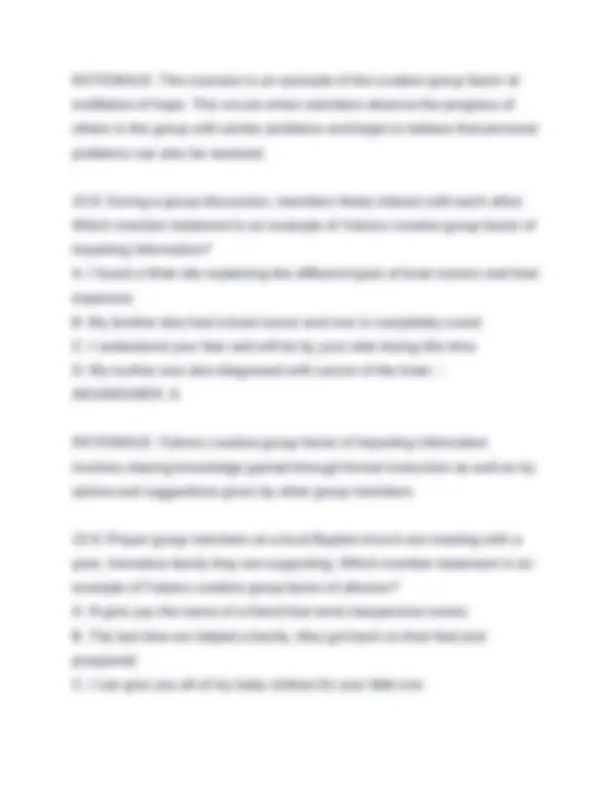
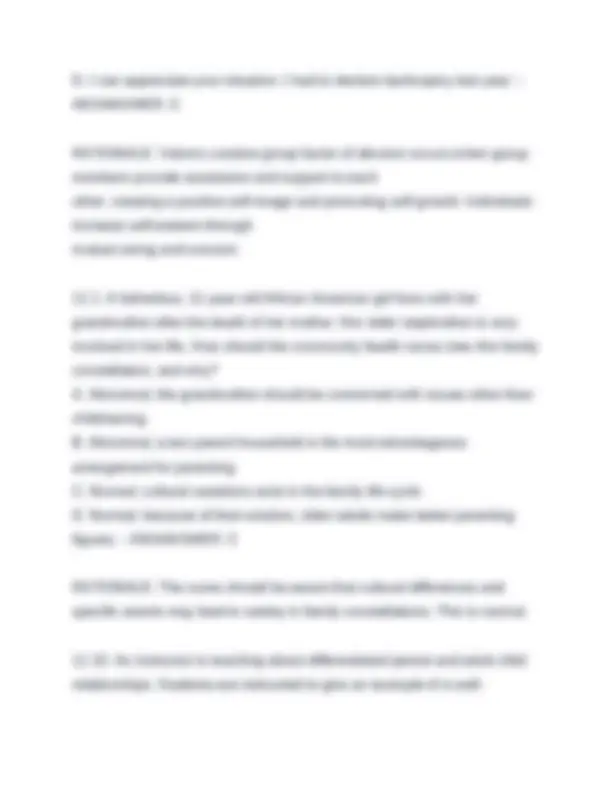
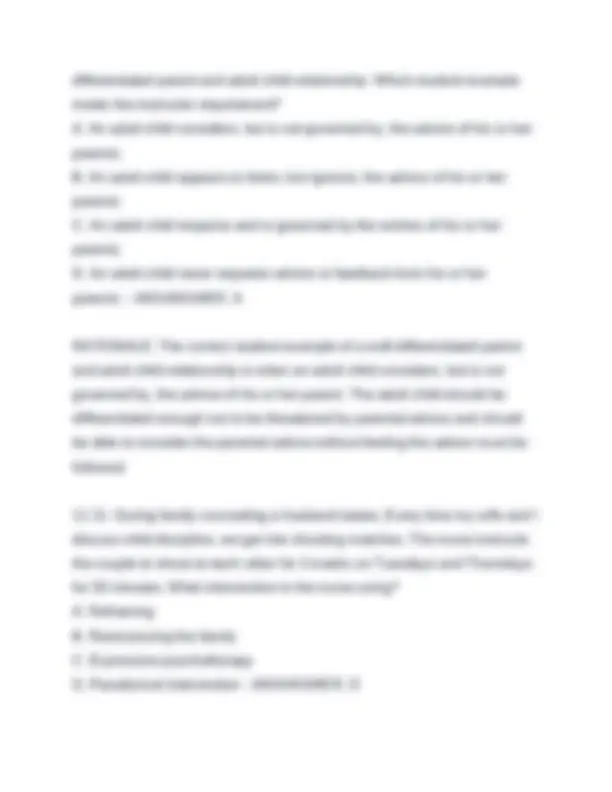
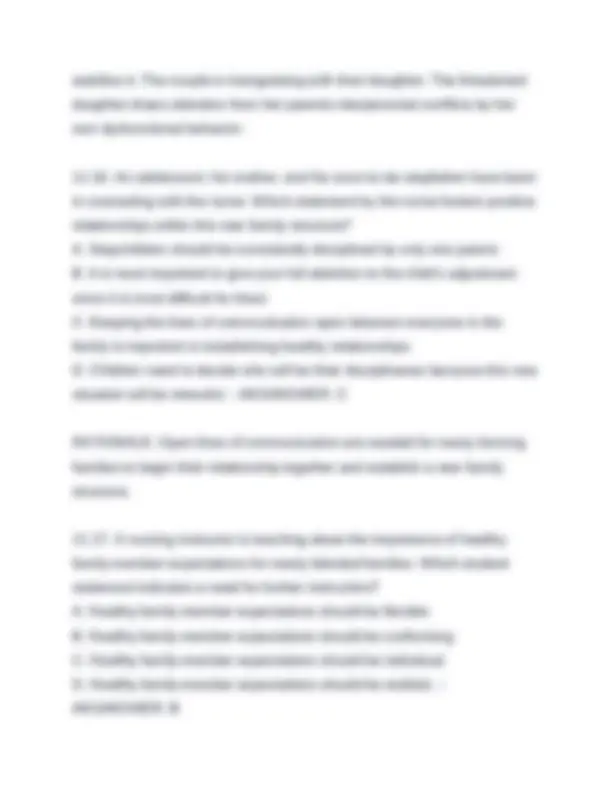
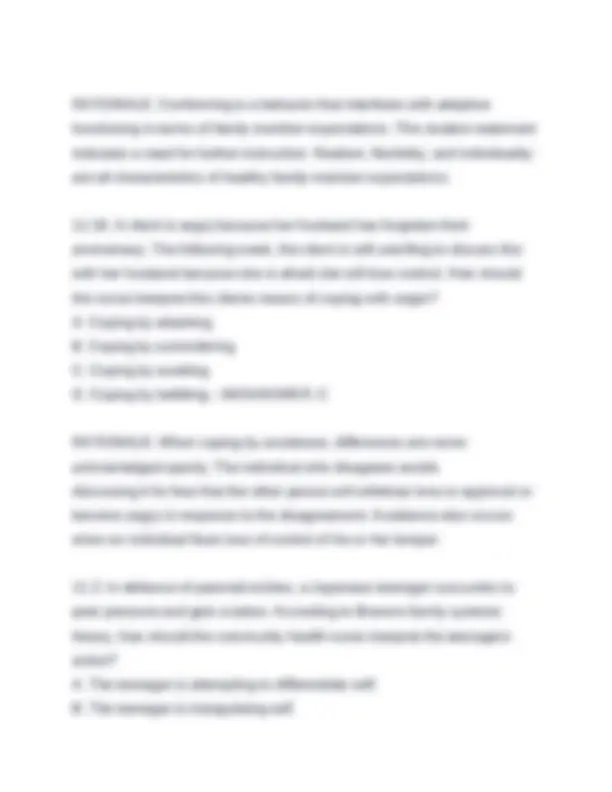
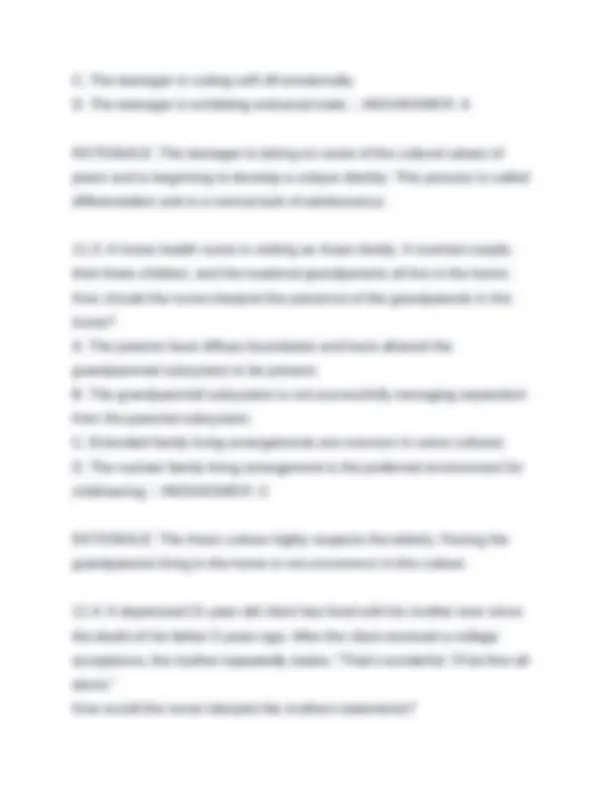
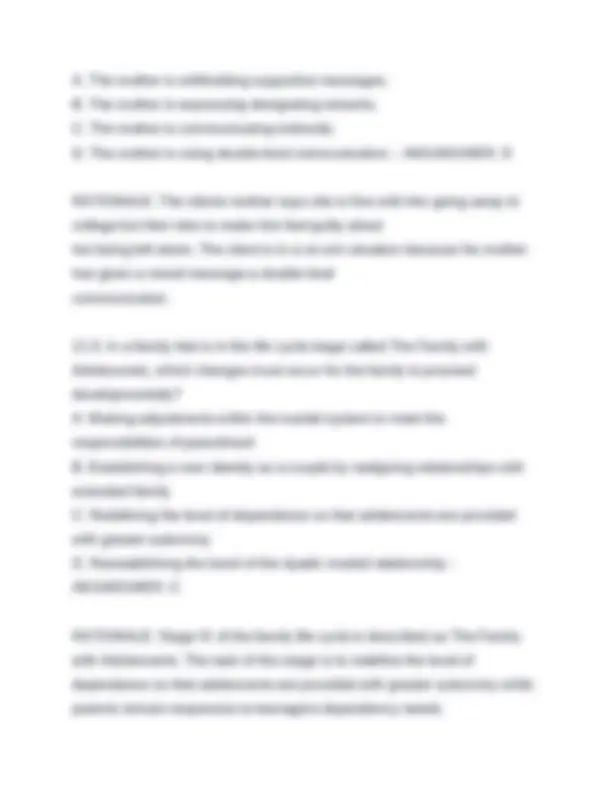
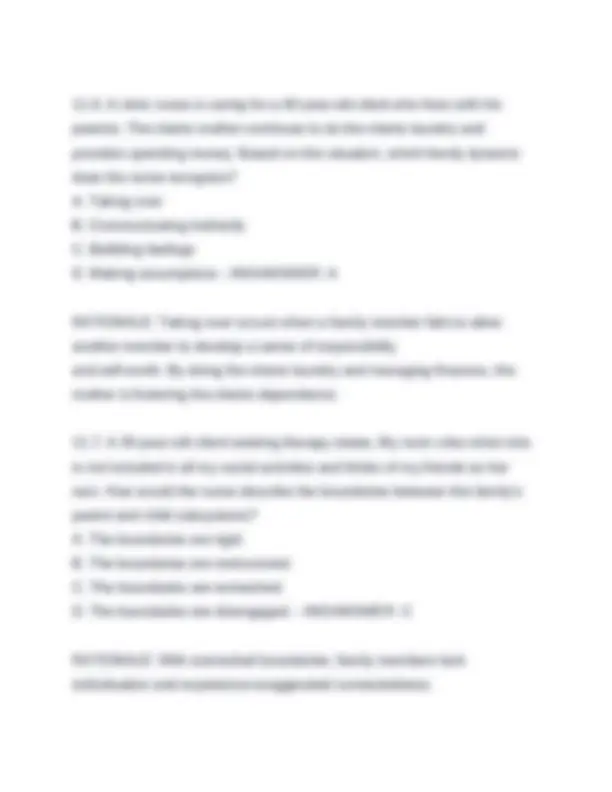
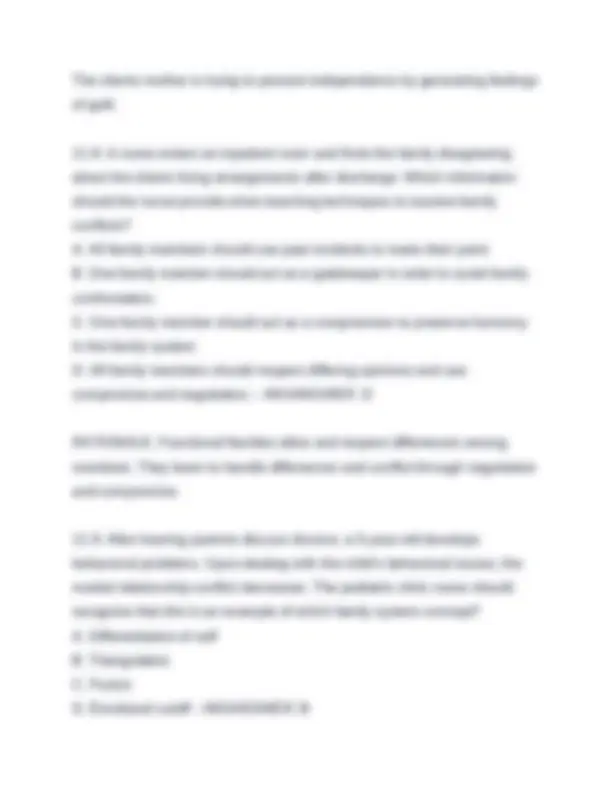
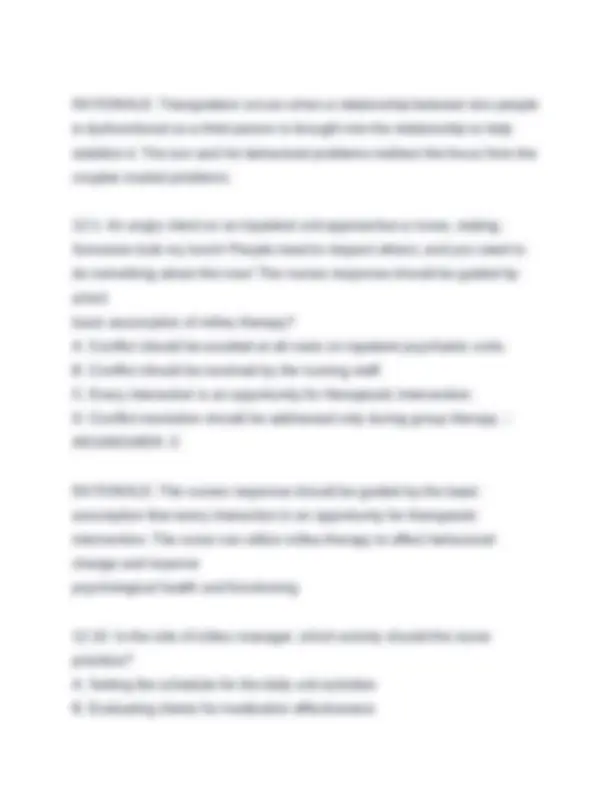
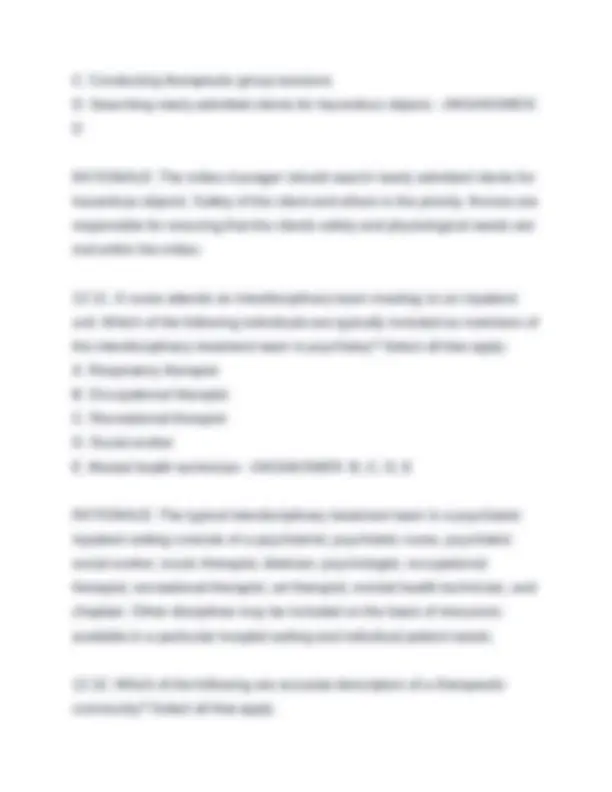
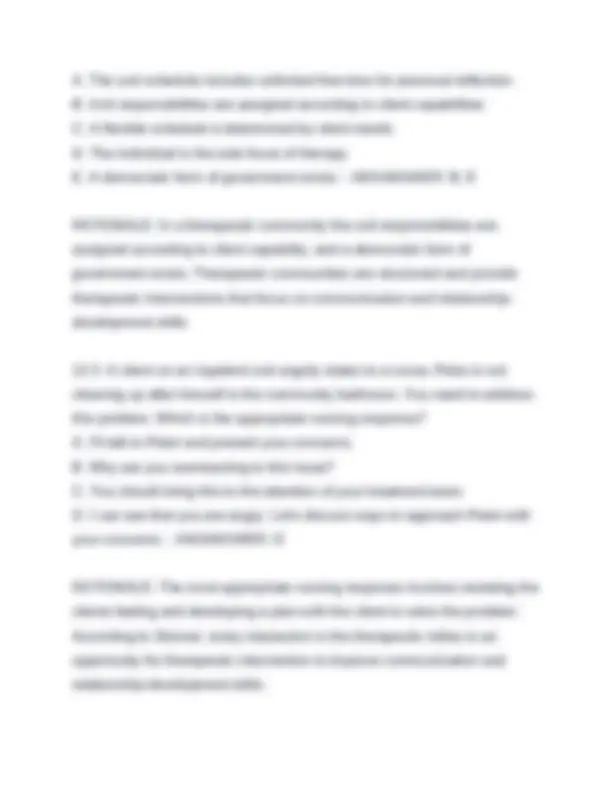
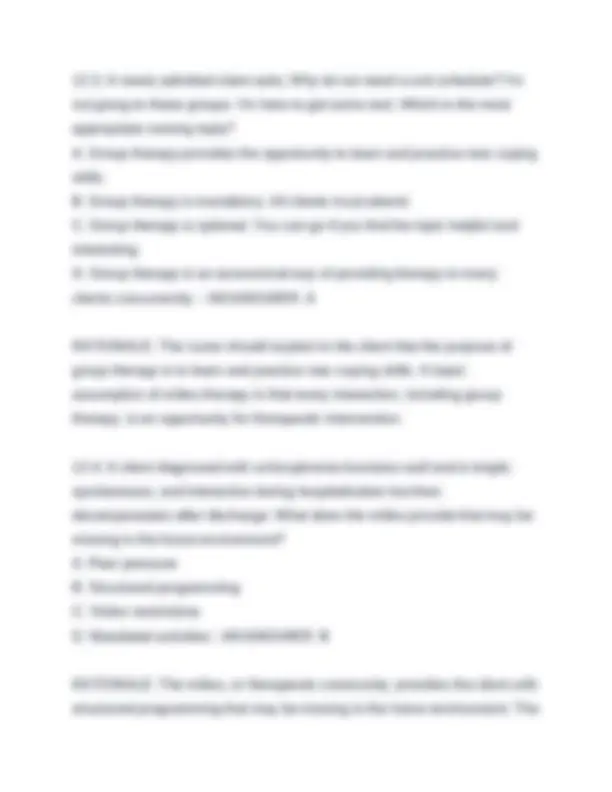
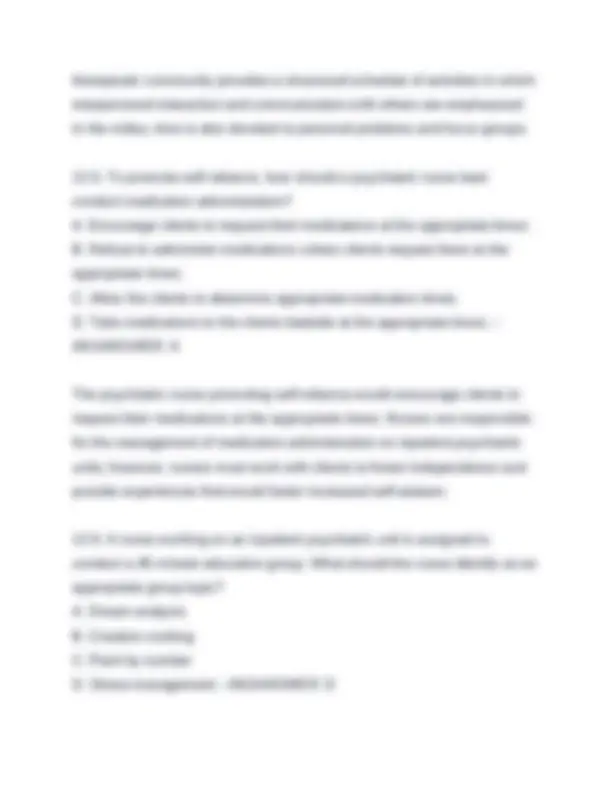
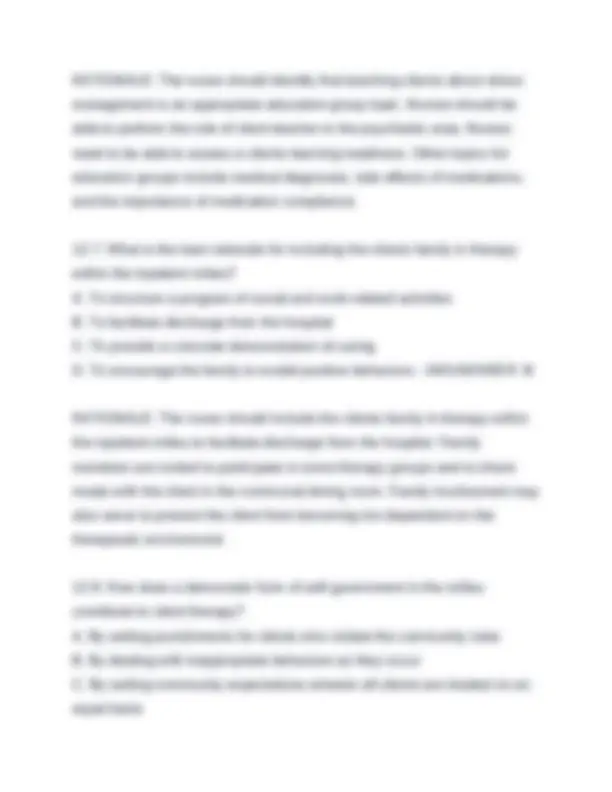
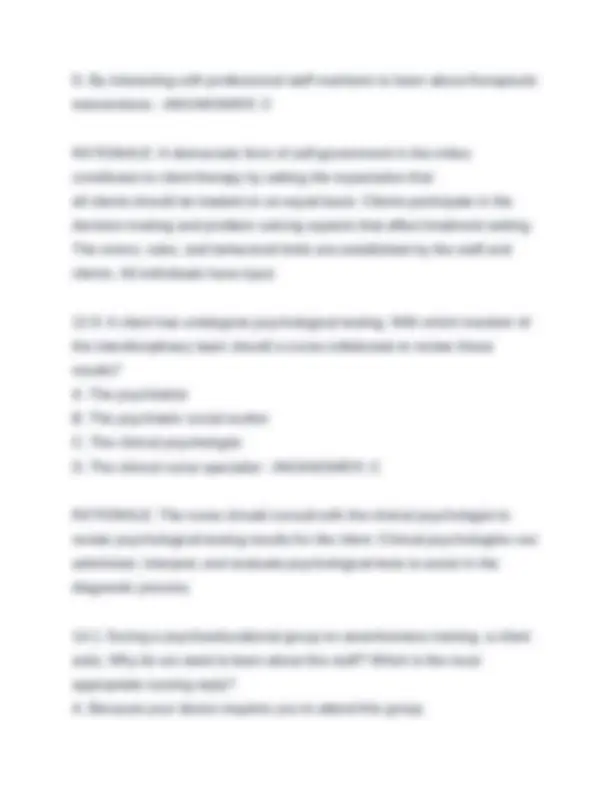
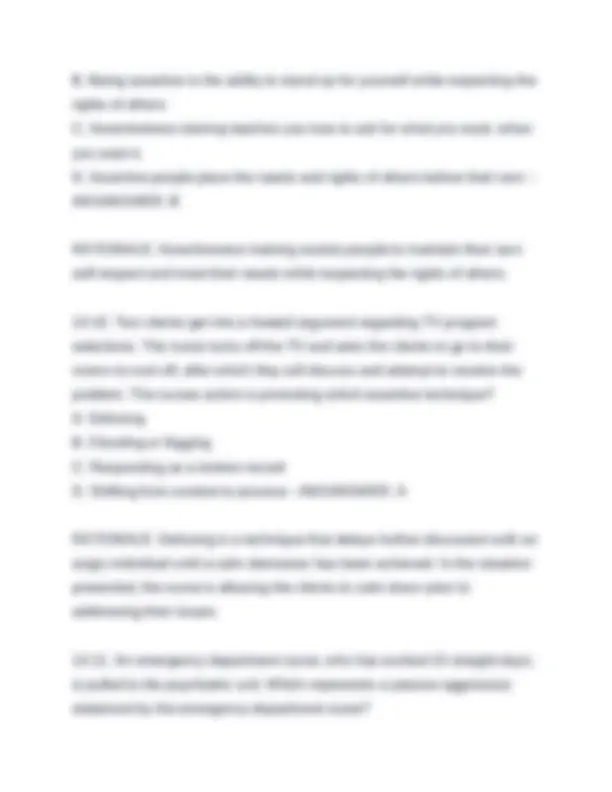
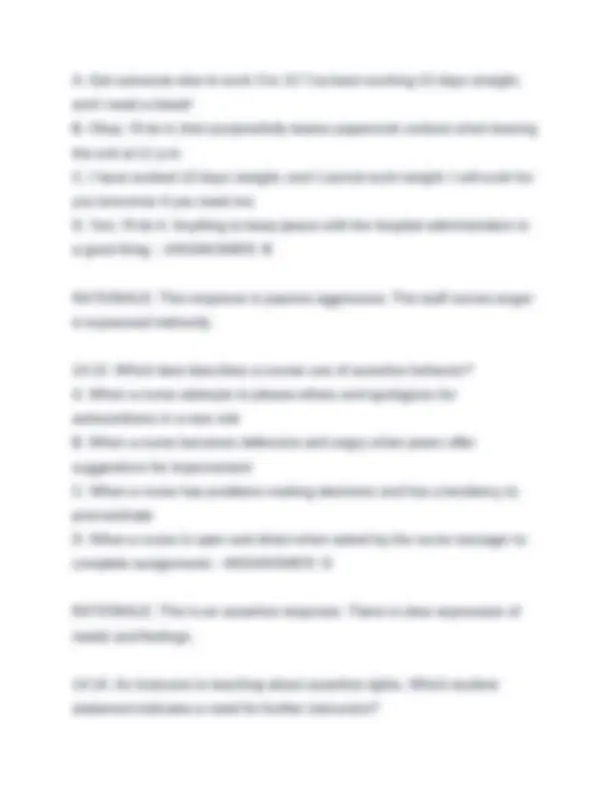
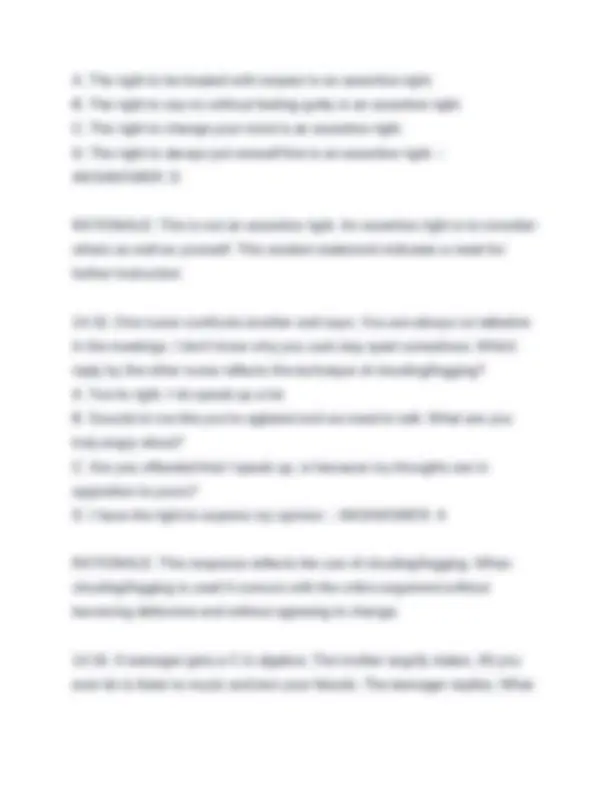
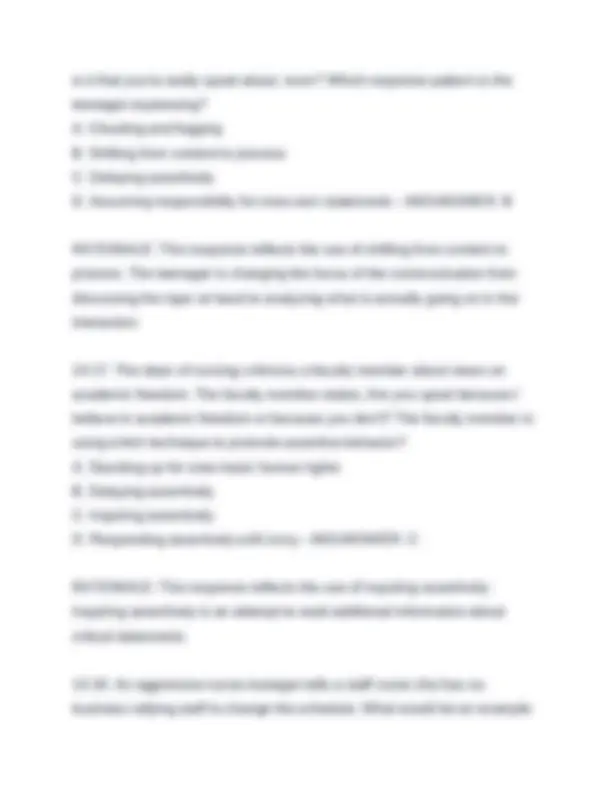
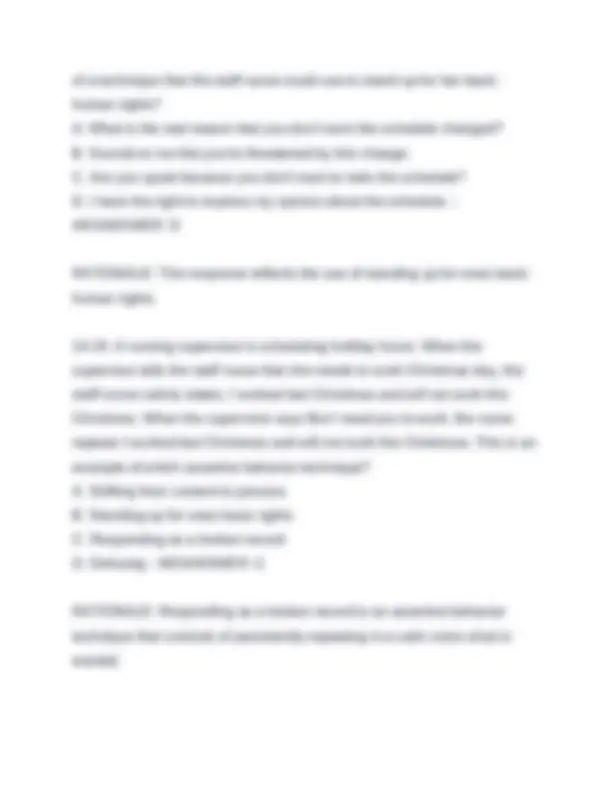
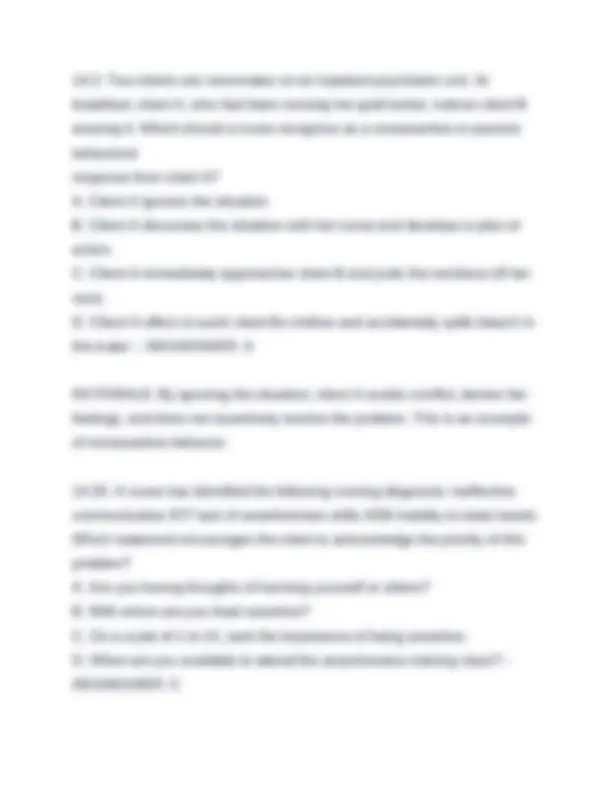
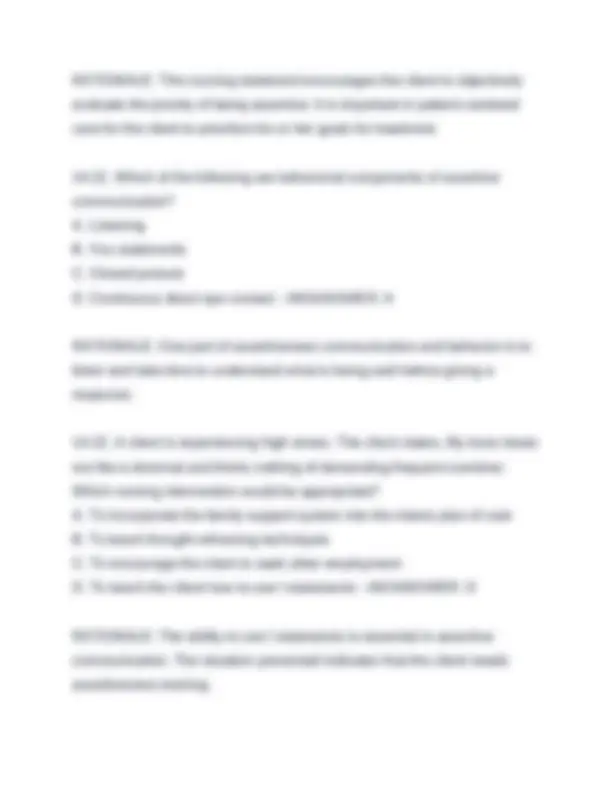
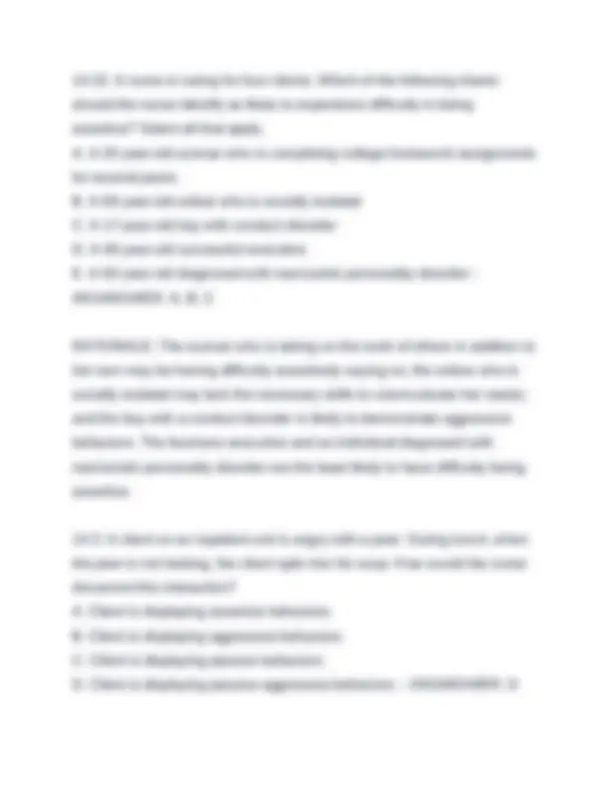
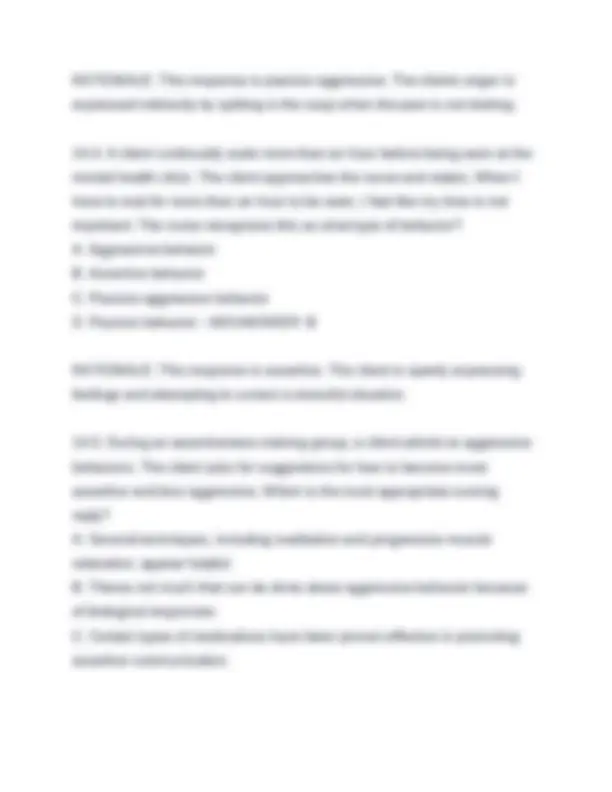
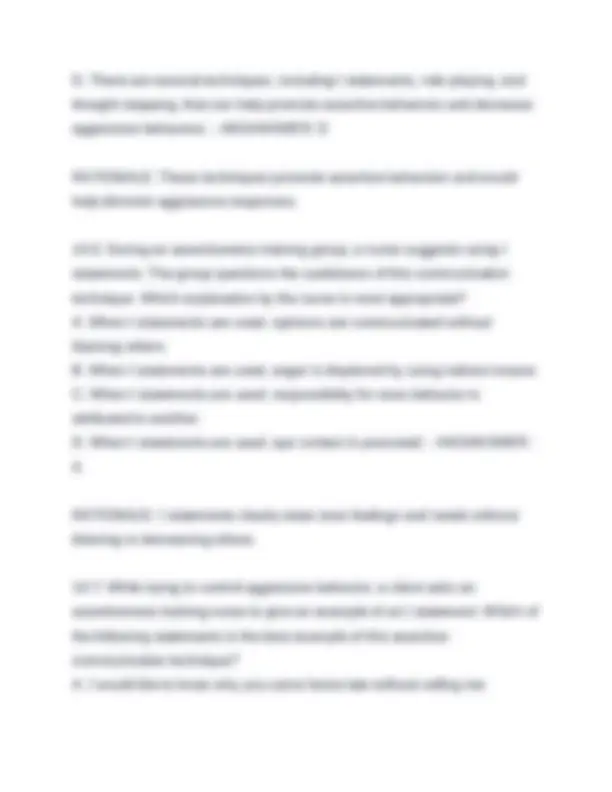
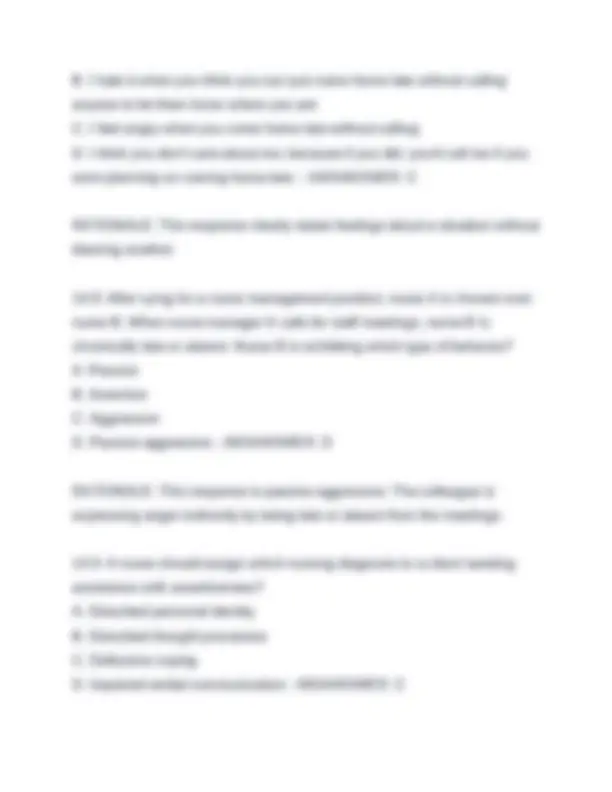
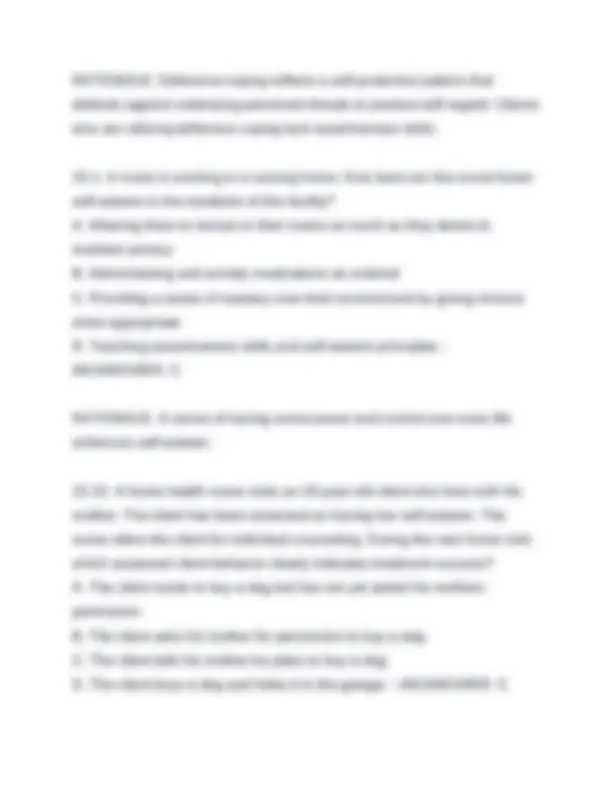
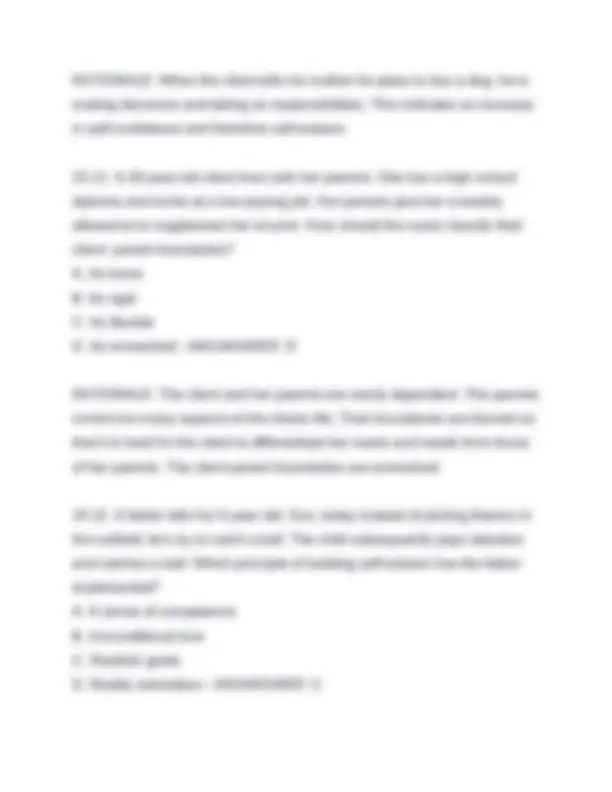
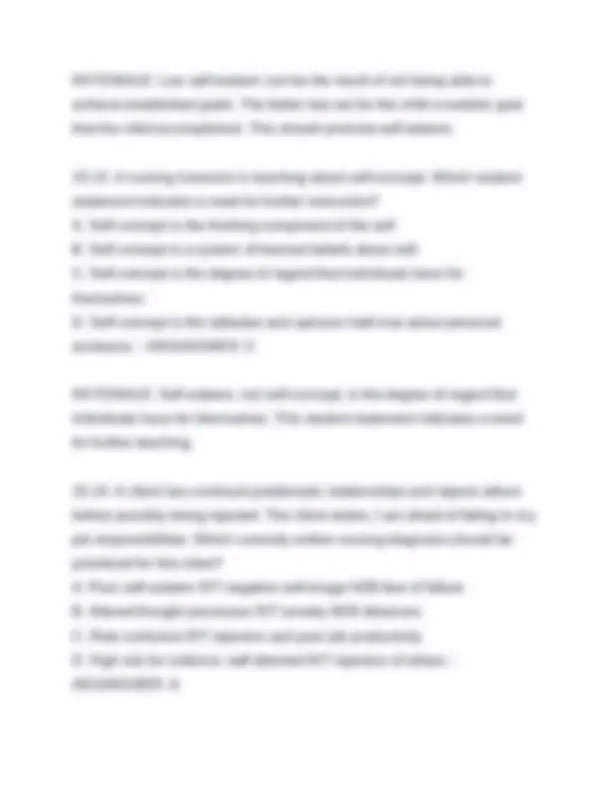
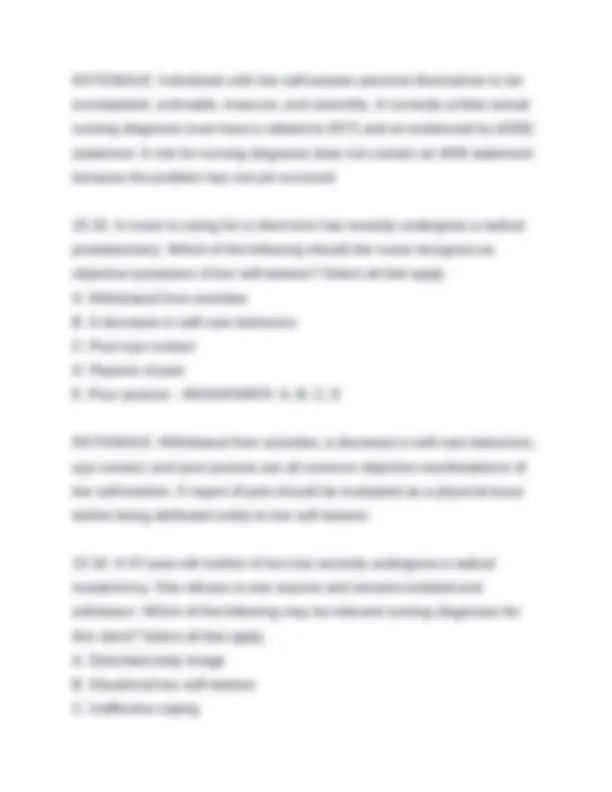
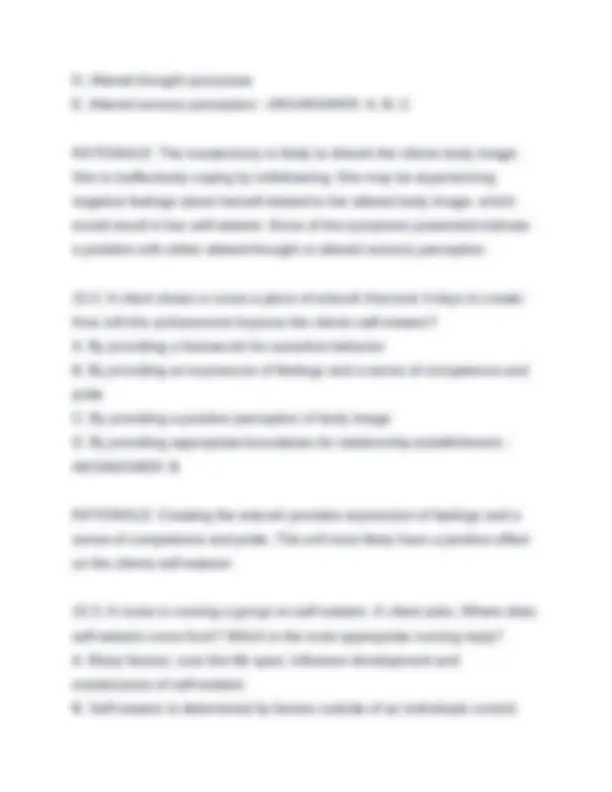
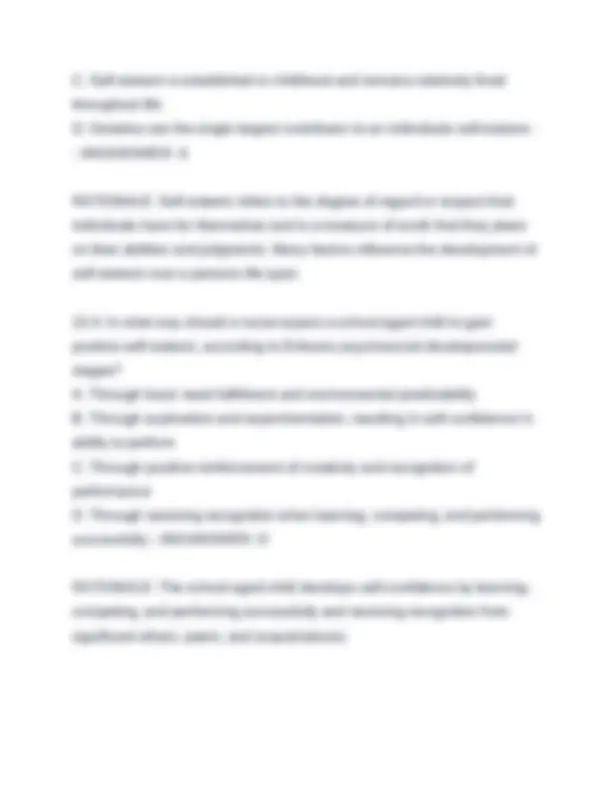
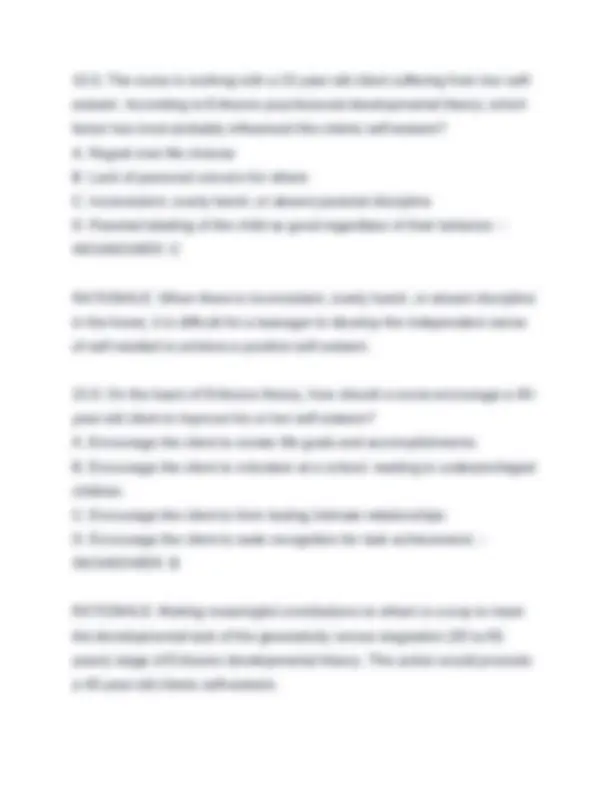
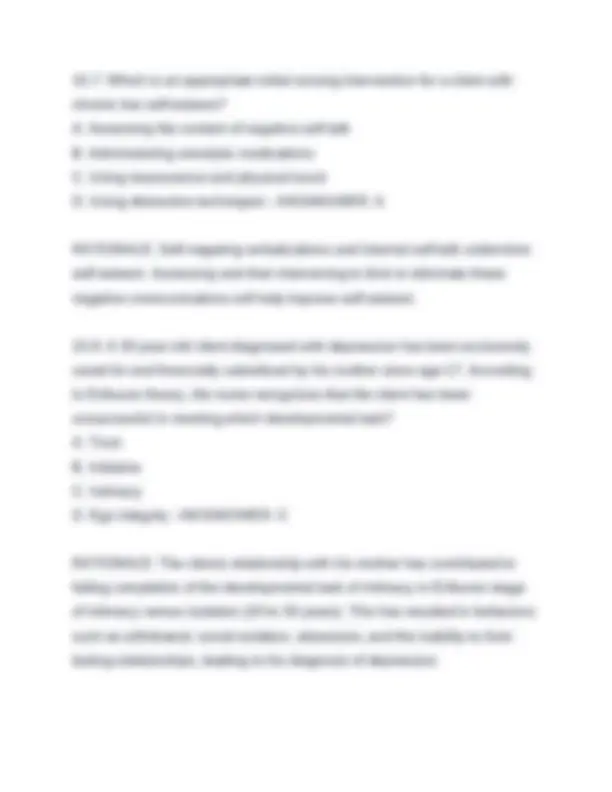
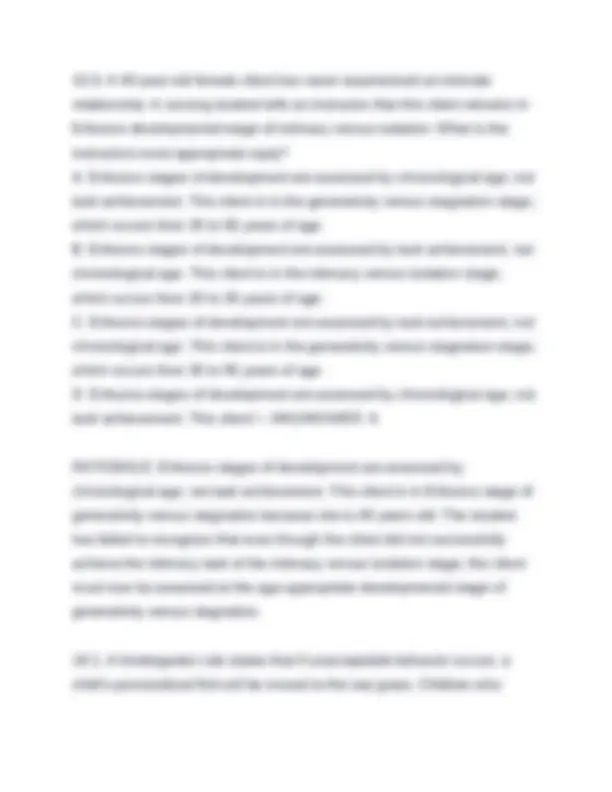
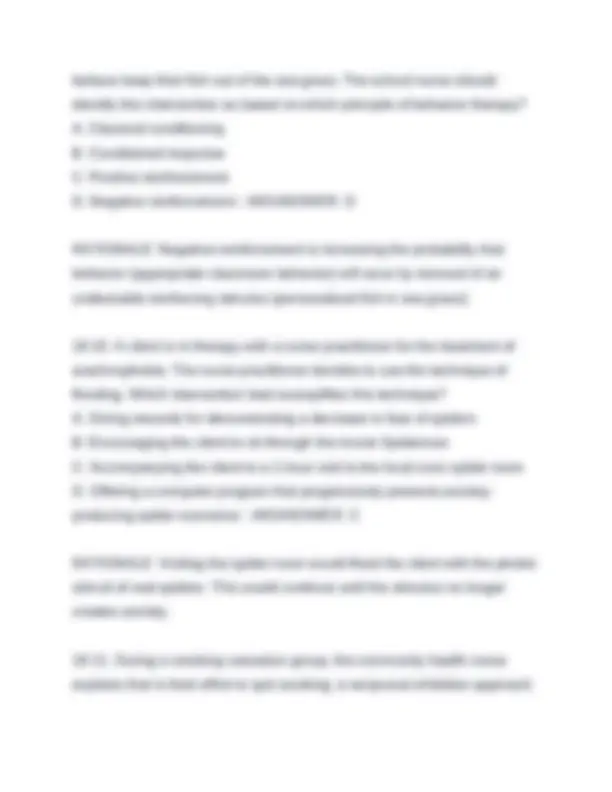
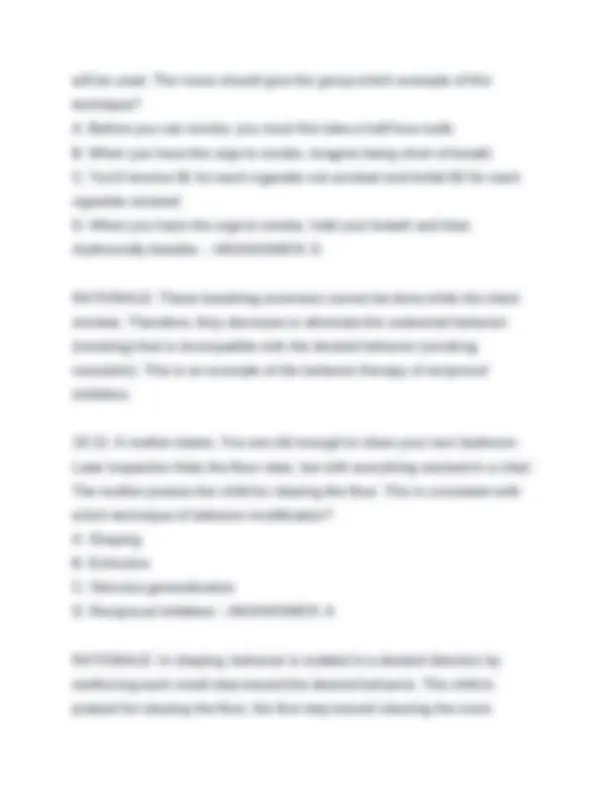
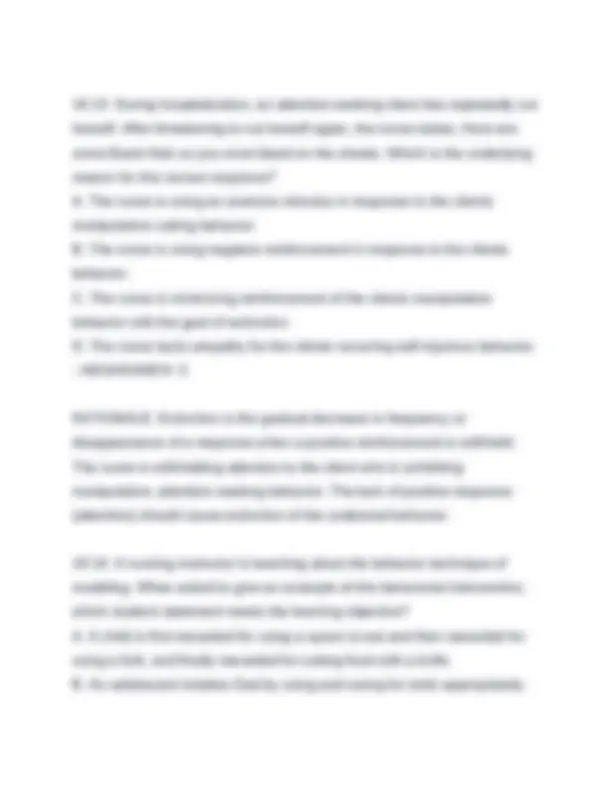
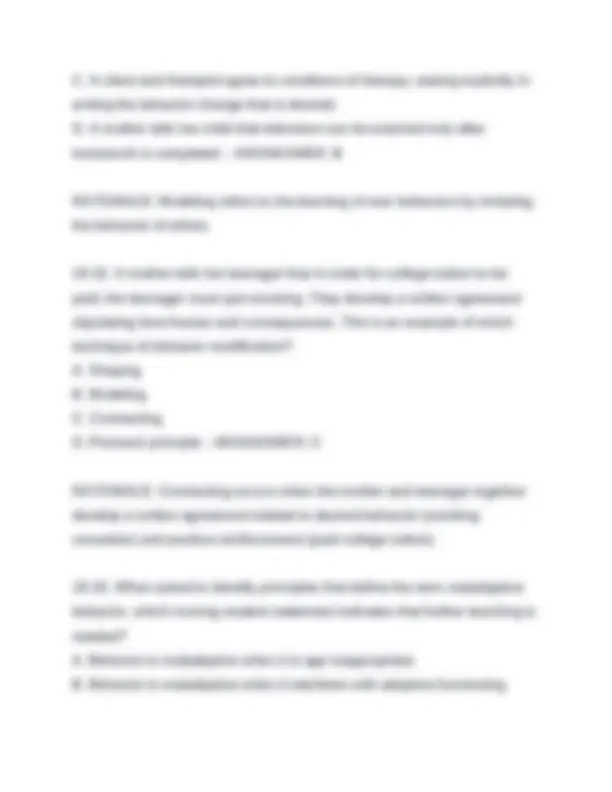
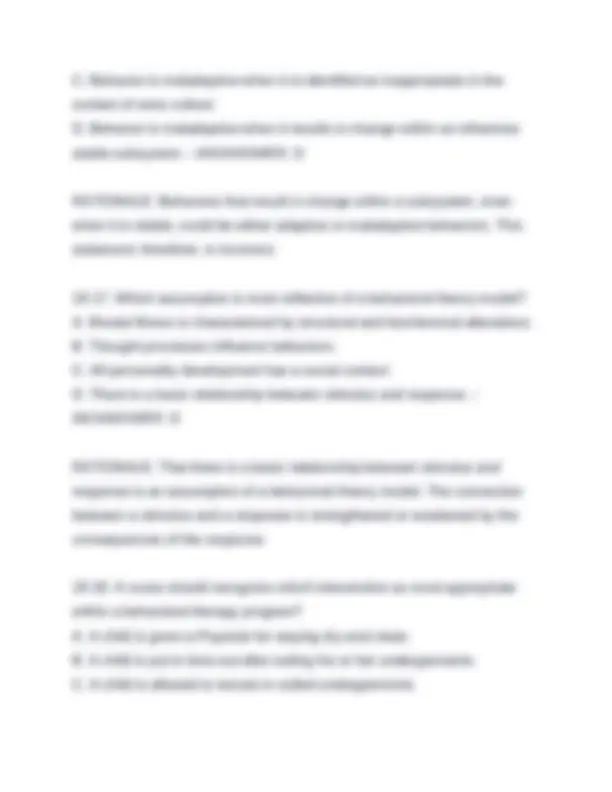
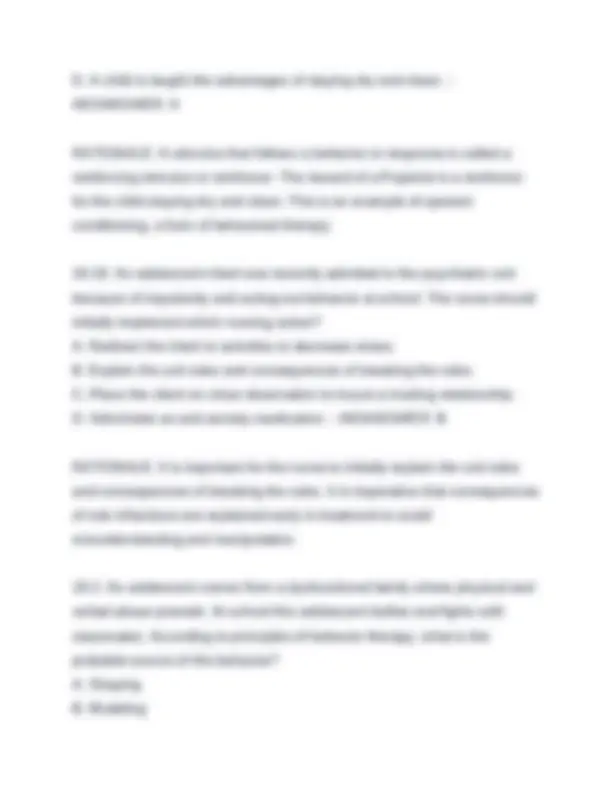
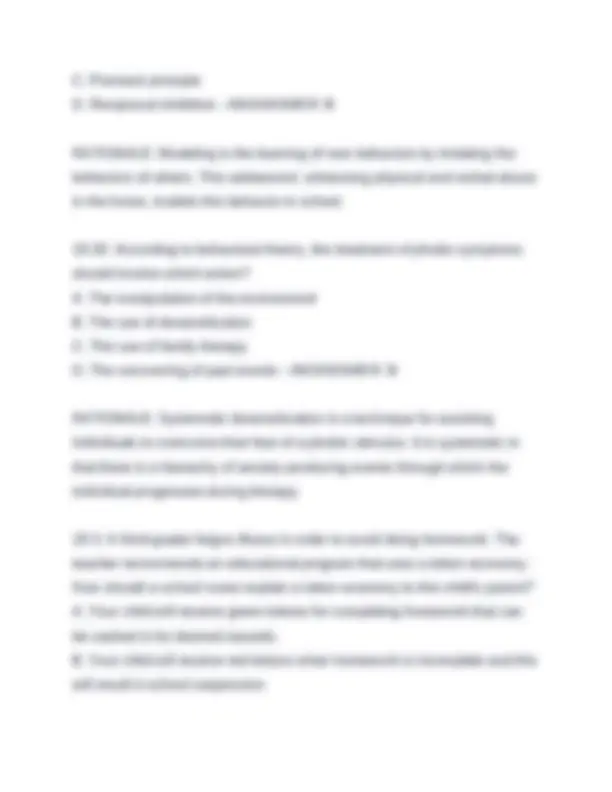
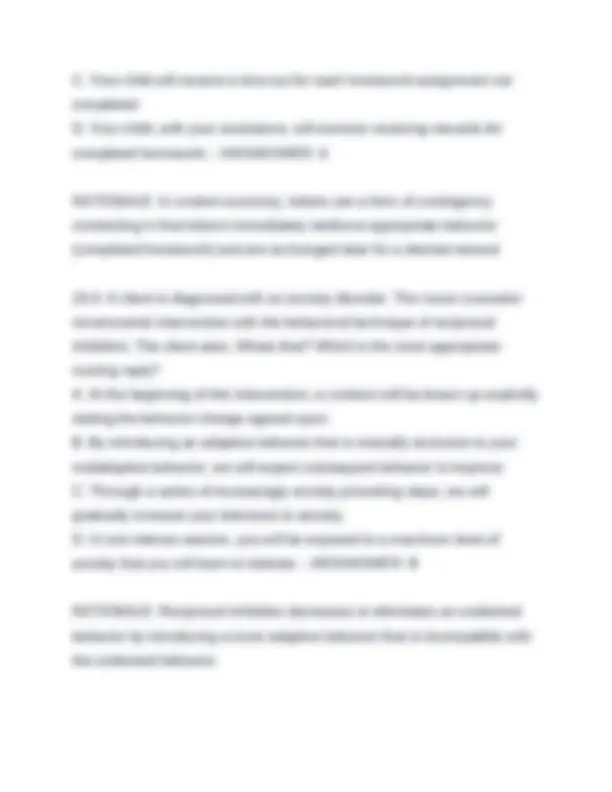
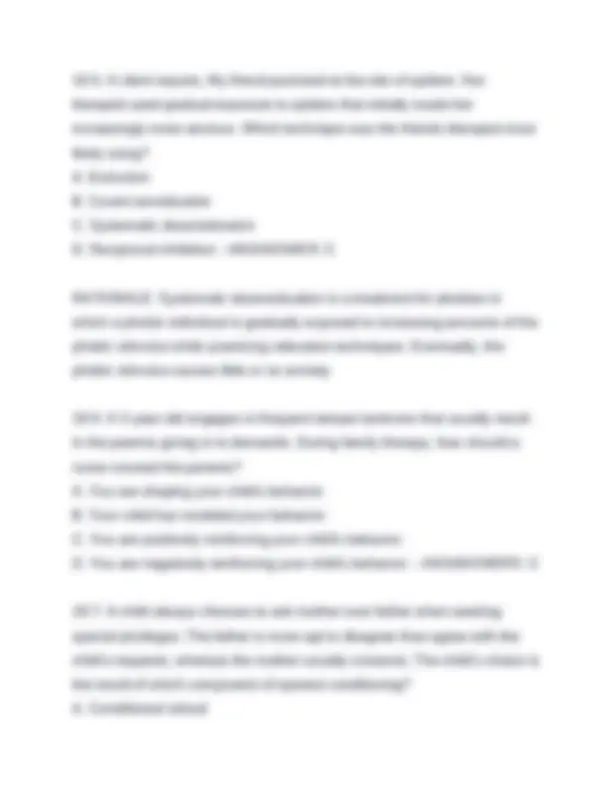
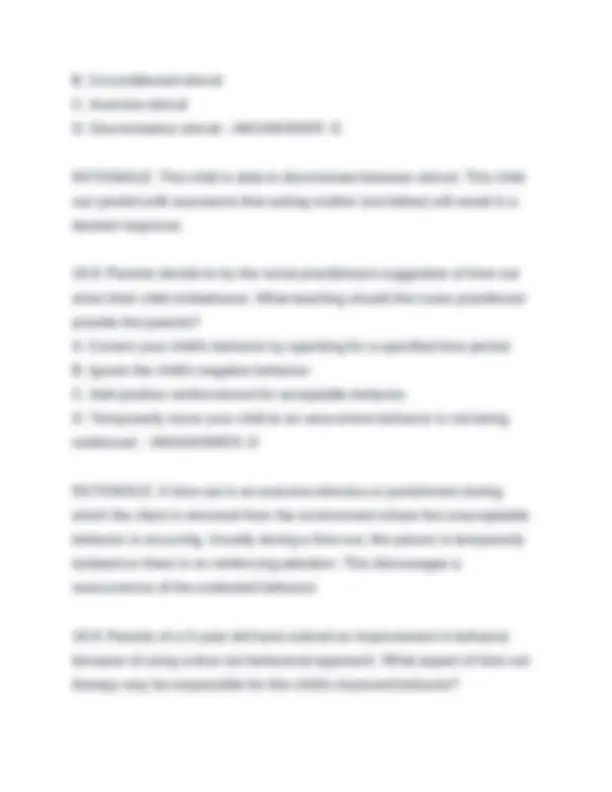
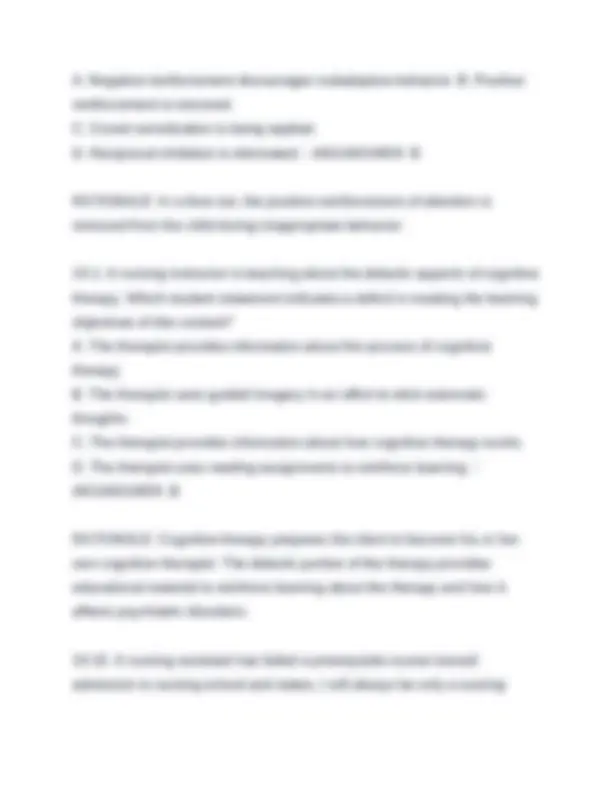
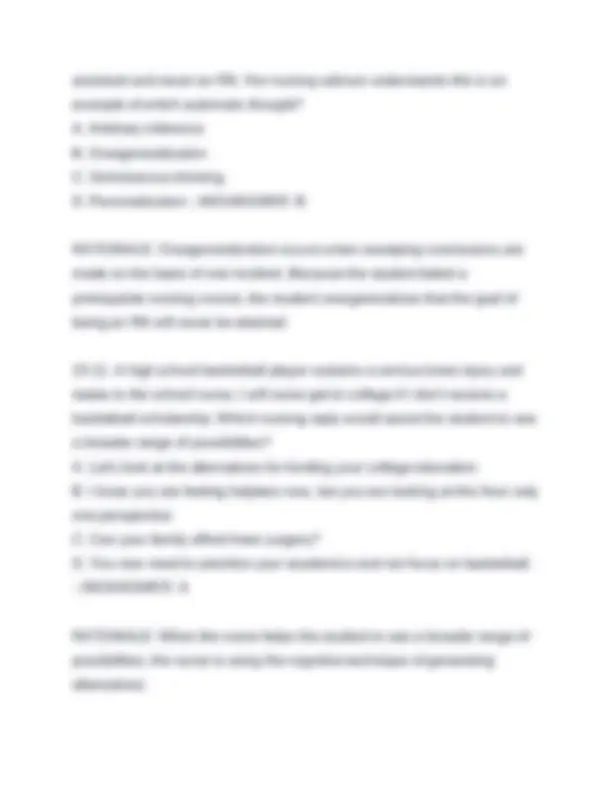
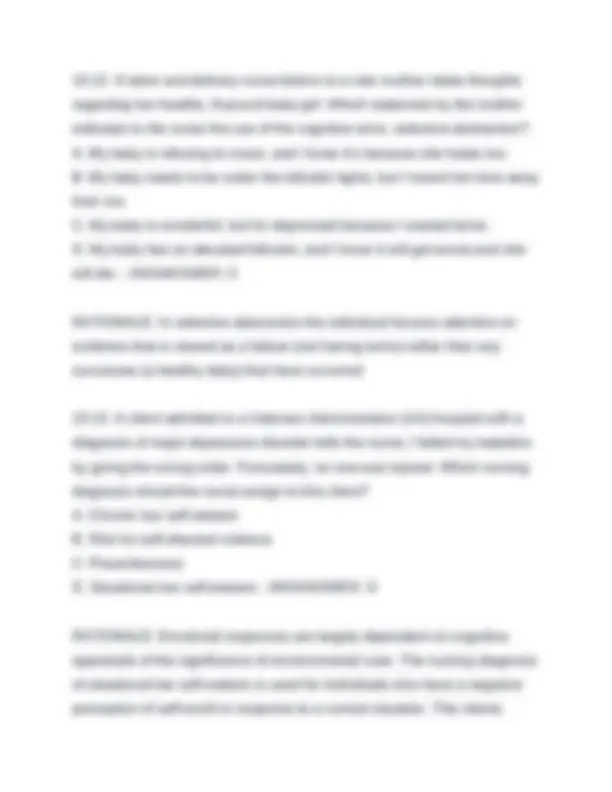
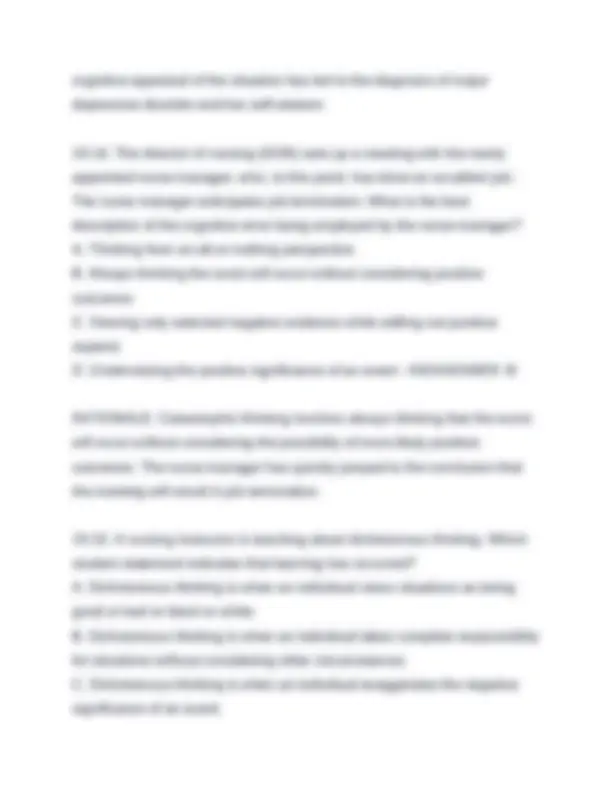
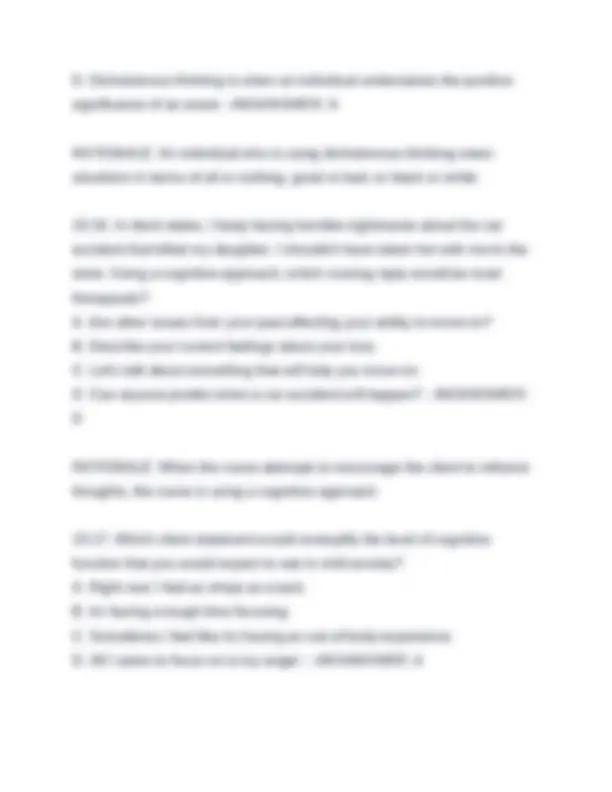
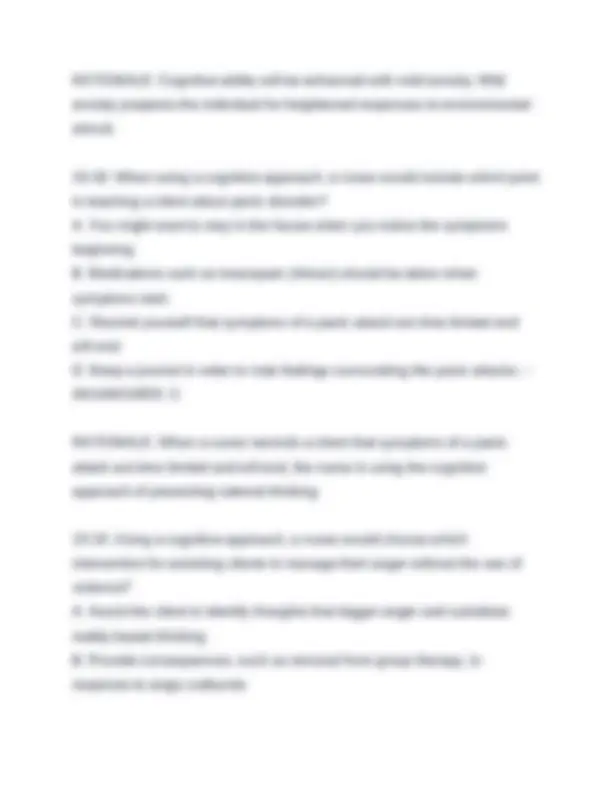
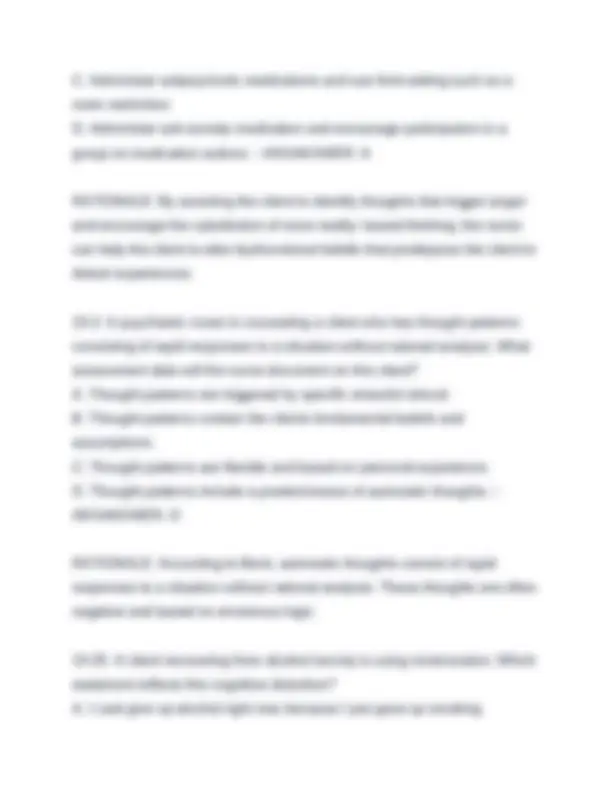
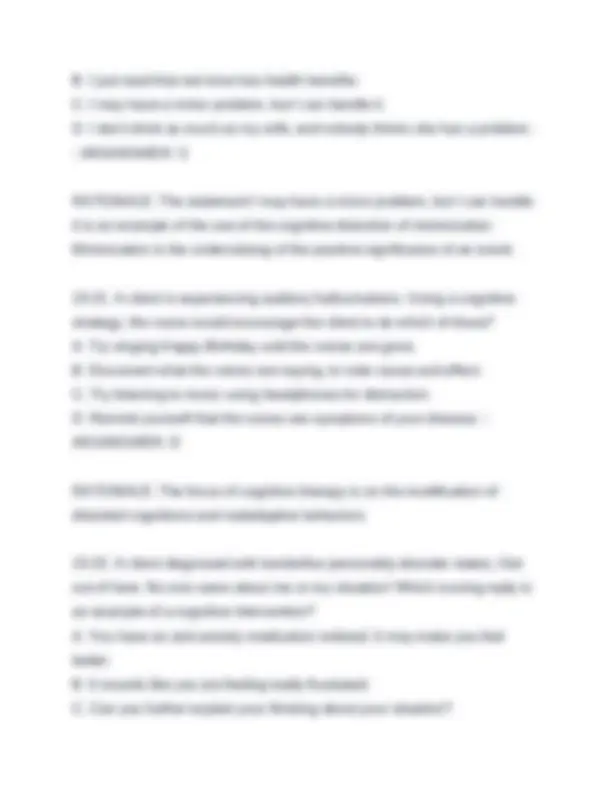
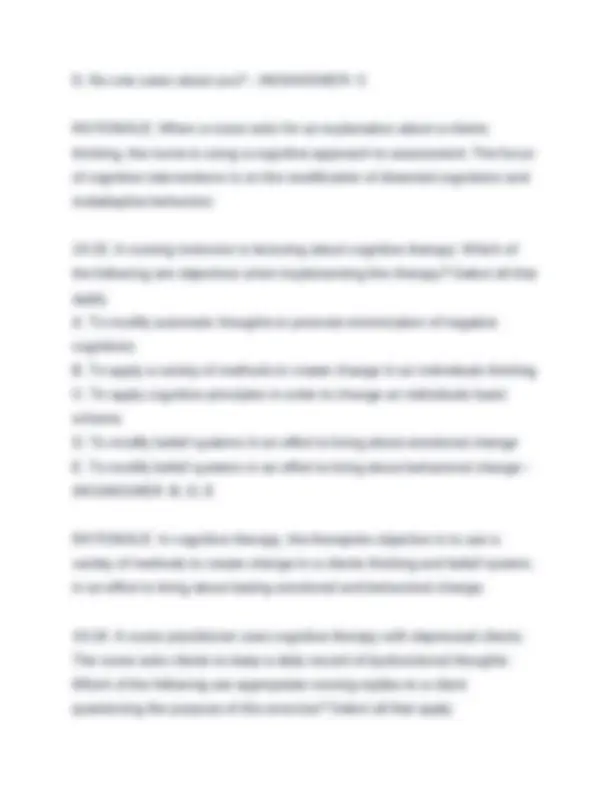
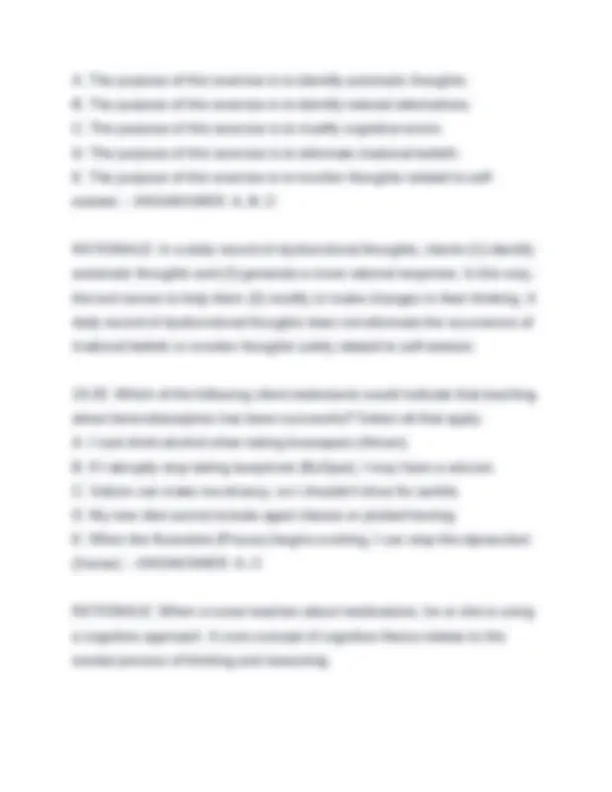
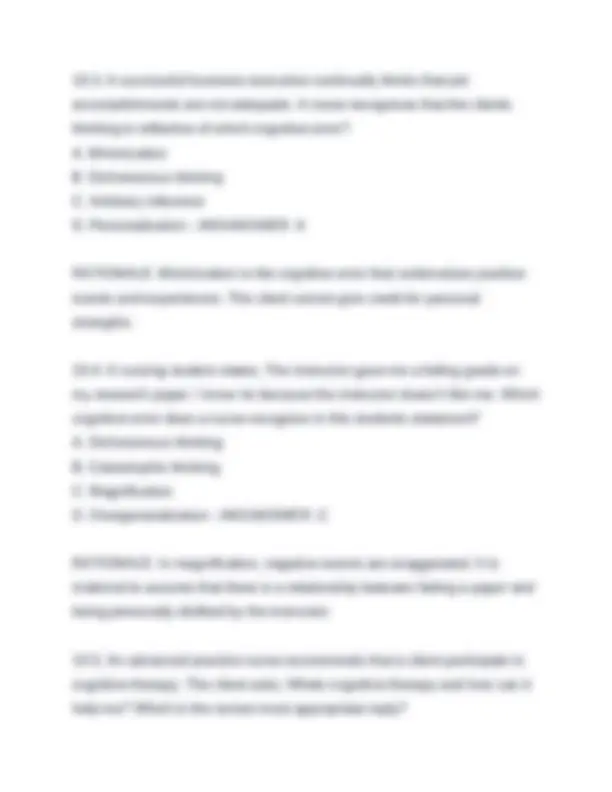

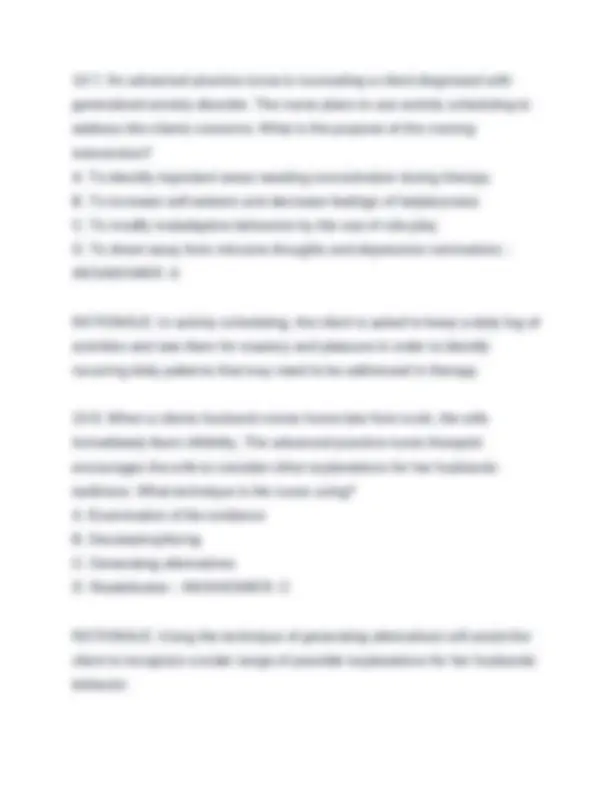
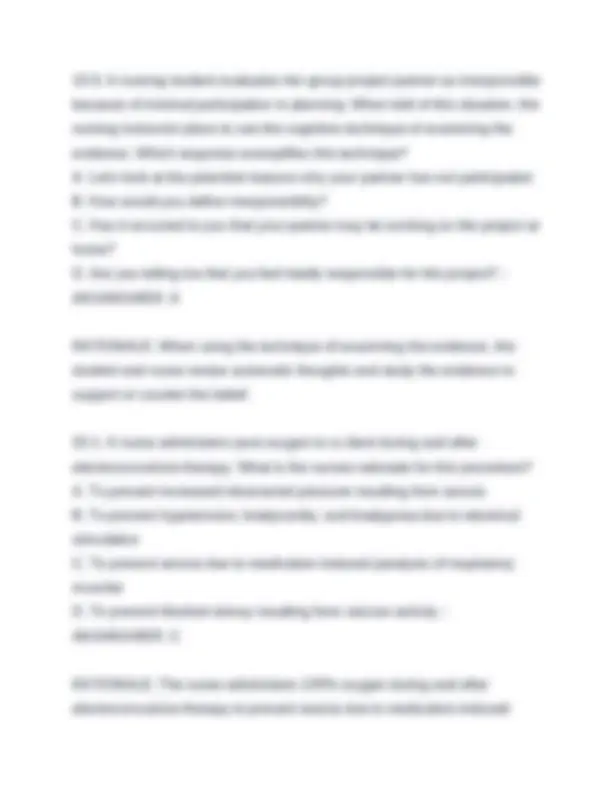
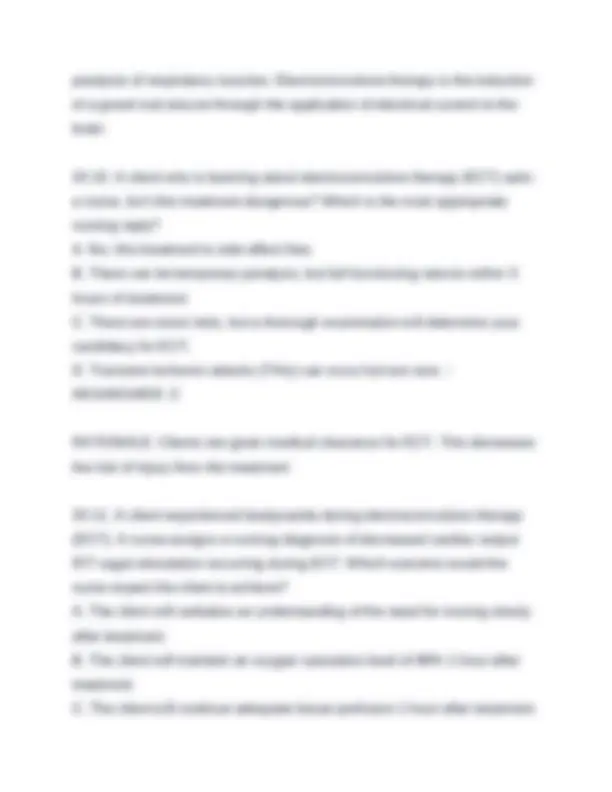
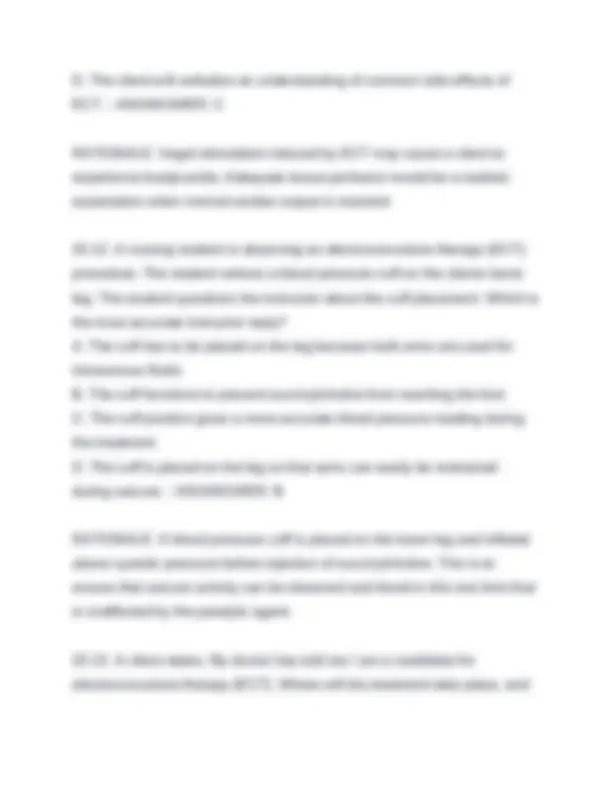
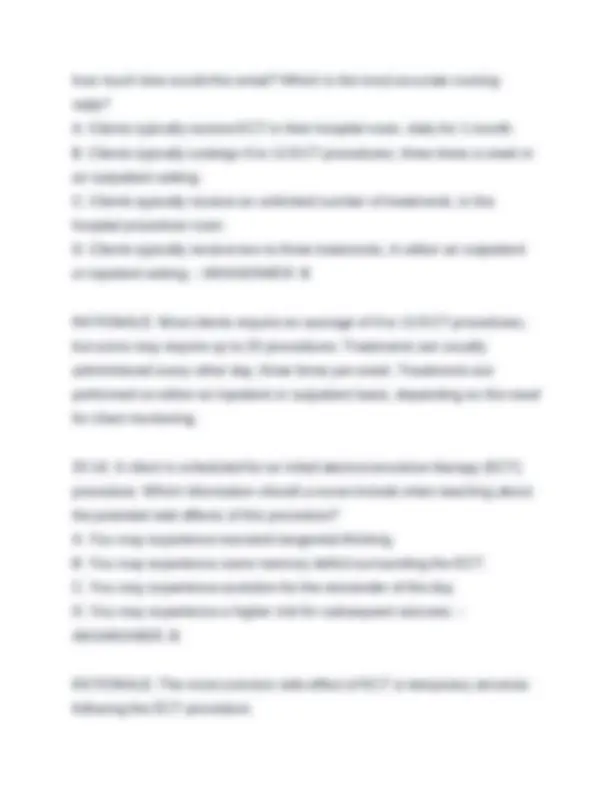
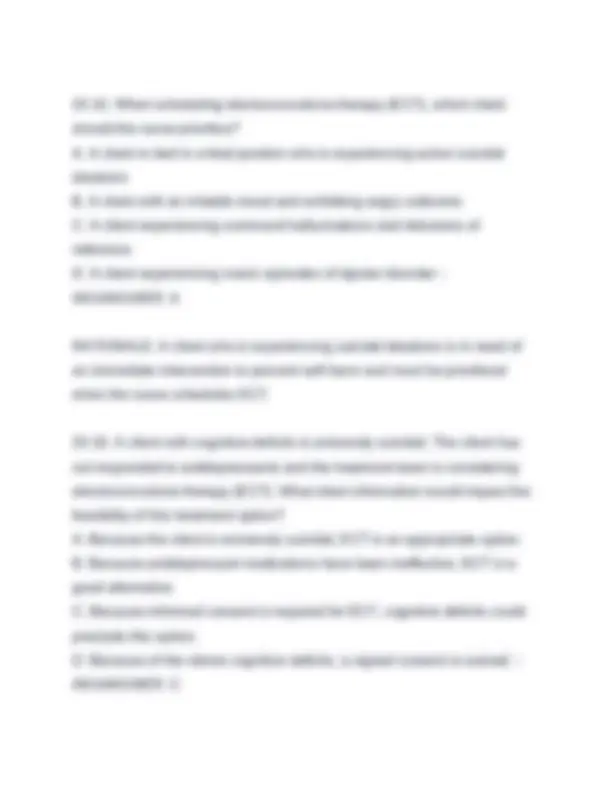
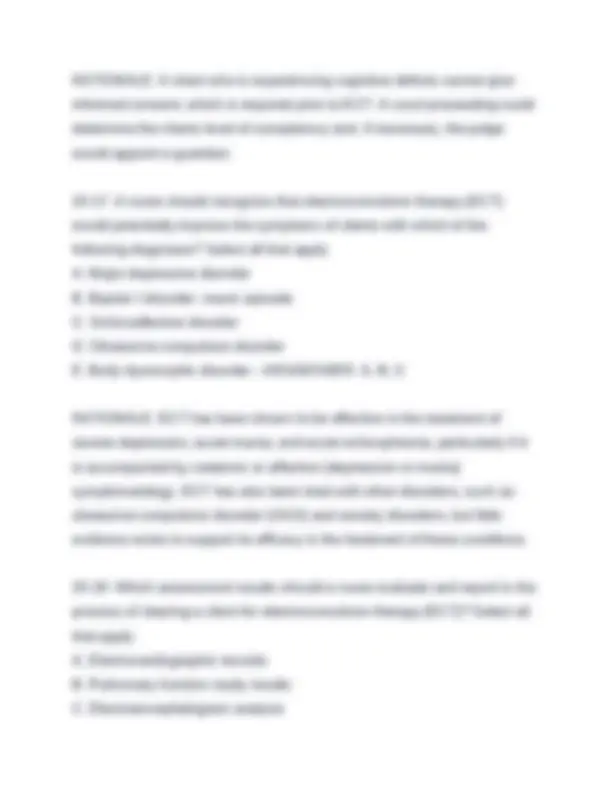
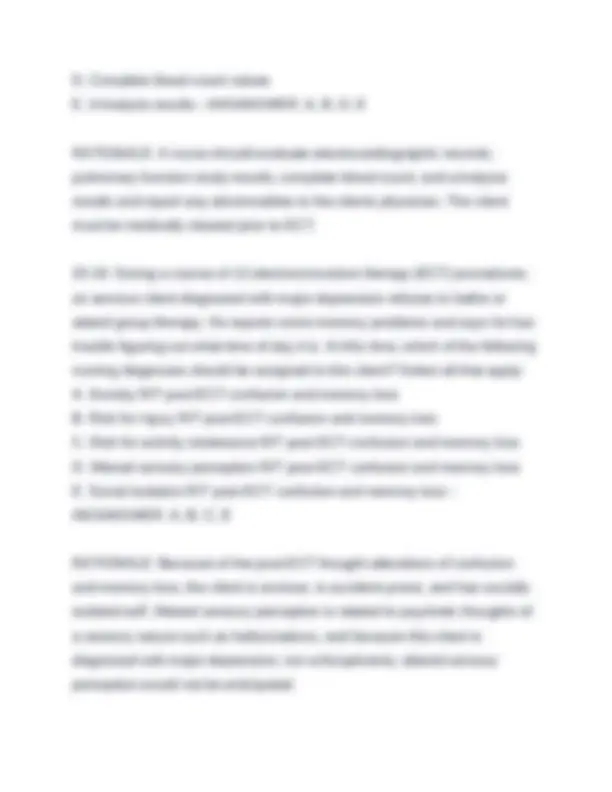

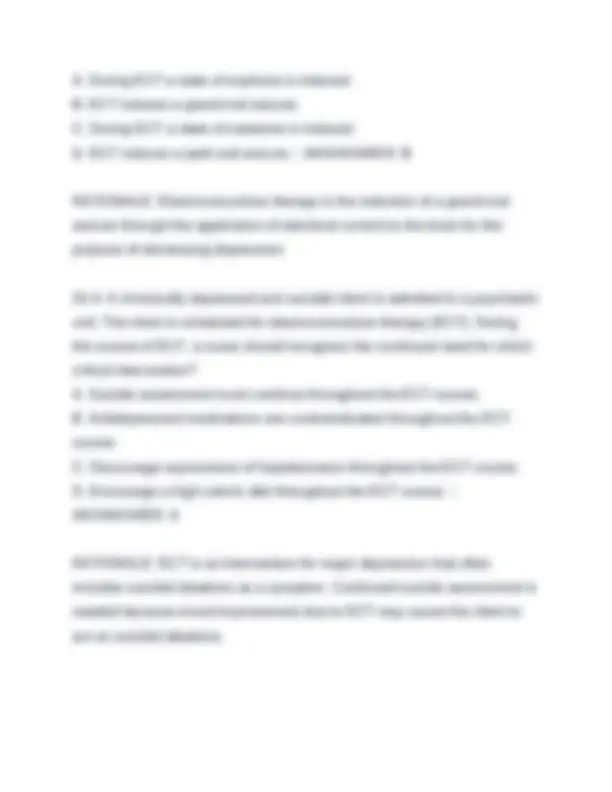
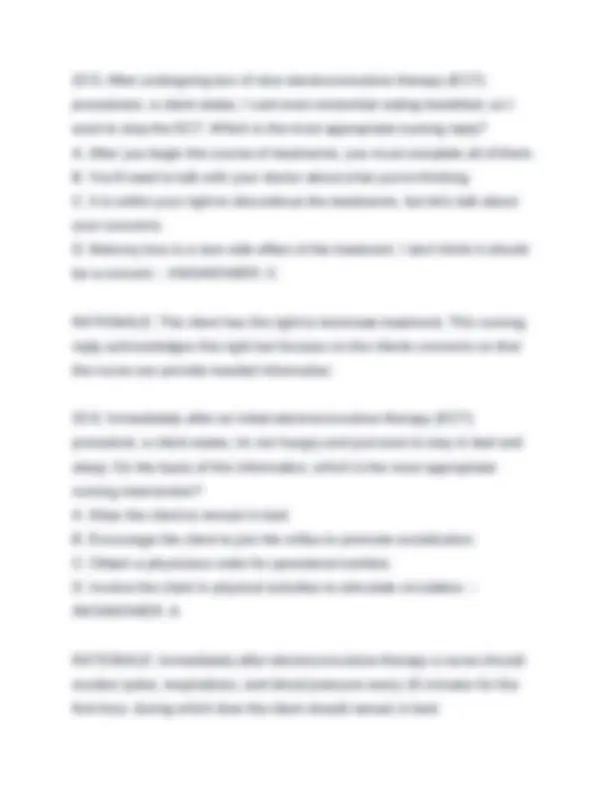
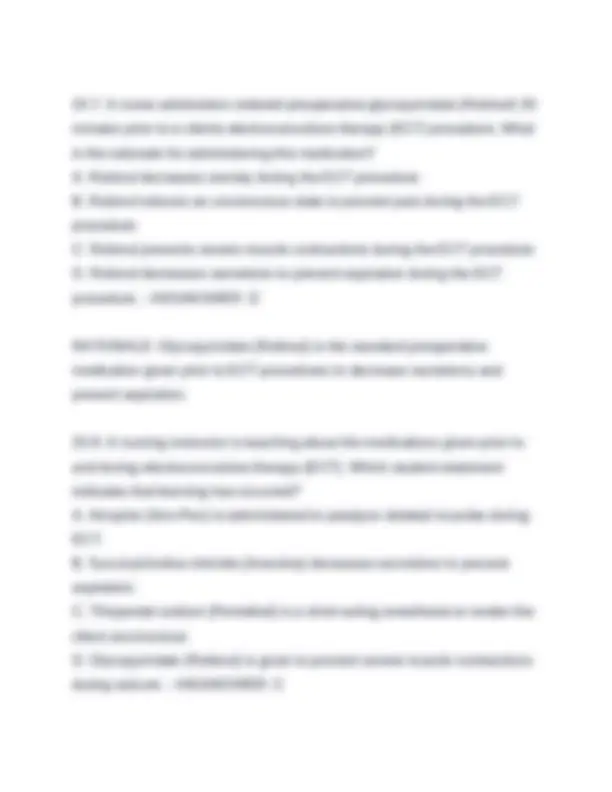
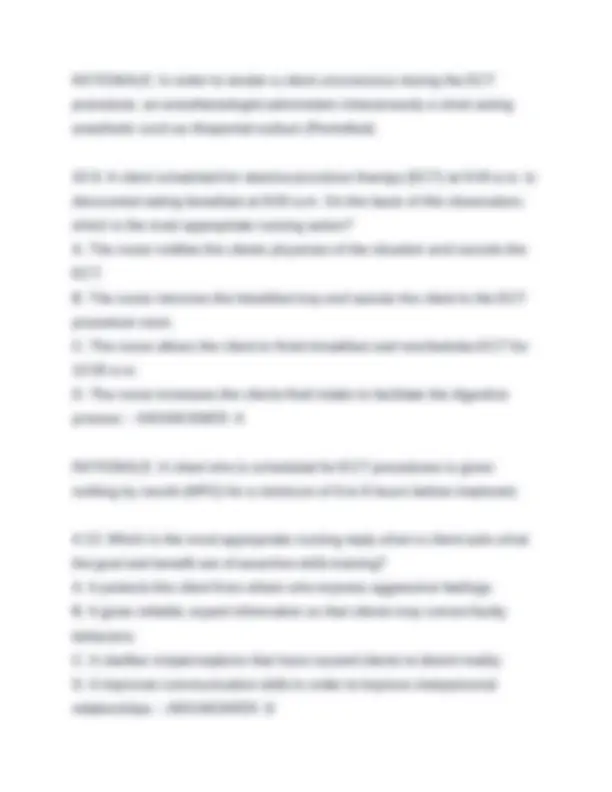
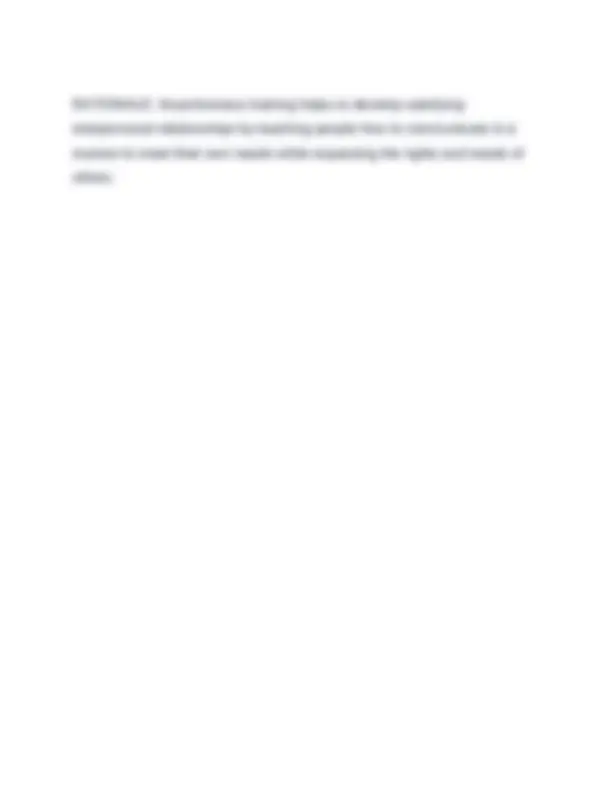


Study with the several resources on Docsity

Earn points by helping other students or get them with a premium plan


Prepare for your exams
Study with the several resources on Docsity

Earn points to download
Earn points by helping other students or get them with a premium plan
Community
Ask the community for help and clear up your study doubts
Discover the best universities in your country according to Docsity users
Free resources
Download our free guides on studying techniques, anxiety management strategies, and thesis advice from Docsity tutors
Unit III Mental Health Test Bank Updated Edition 2025-2026. Questions with Correct Verified Answers. Graded A
Typology: Exams
1 / 86

This page cannot be seen from the preview
Don't miss anything!















































































10.1. During a therapeutic group, a client talks about personal accomplishments in an effort to gain attention. Which group role, assumed by this client, should the nurse identify? A. The task role of gatekeeper B. The individual role of recognition seeker C. The maintenance role of dominator D. The task role of elaborator - ANSANSWER: B RATIONALE: The nurse should evaluate that the client is assuming the individual role of the recognition seeker. Other individual roles include the aggressor, the blocker, the dominator, the help seeker, the monopolizer, and the seducer. 10.10. During an inpatient educational group, a client shouts out, This information is worthless. Nothing you have said can help me. These statements indicate to the nurse leader that the client is assuming which group role? A. The group role of aggressor B. The group role of initiator C. The group role of gatekeeper D. The group role of blocker - ANSANSWER: A
RATIONALE: The nurse should identify that the client is assuming the group role of the aggressor. The aggressor expresses negativism and hostility toward others in the group or to the group leader and may use sarcasm in an effort to degrade the status of others. 10.11. A nurse believes that the members of a parenting group are in the initial, or orientation, phase of group development. Which group behaviors would support this assumption? A. The group members manage conflict within the group. B. The group members use denial as part of the grief response. C. The group members compliment the leader and compete for the role of recorder. D. The group members initially trust one another and the leader. - ANSANSWER: C RATIONALE: The nurse should anticipate that members in the initial, or orientation, phase of group development often compliment the leader and compete for the role of recorder. Members in this phase have not yet established trust and have a fear of not being accepted. Power struggles may occur as members compete for their position in the group. 10.12. During a group session, which client statement demonstrates that the group has progressed to the middle, or working, phase of group development? A. Its hard for me to tell my story when I'm not sure about the reactions of others.
has occurred, and encourage members to provide feedback to each other about progress. 10.14. A nursing instructor is teaching students about self-help groups like Alcoholics Anonymous (AA). Which student statement indicates that learning has occurred? A. There is little research to support AAs effectiveness. B. Self-help groups used to be the treatment of choice, but their popularity is waning. C. These groups have no external regulation, so clients need to be cautious. D. Members themselves run the group, with leadership usually rotating among the members. - ANSANSWER: D RATIONALE: The student indicates an understanding of self-help groups when stating, Members themselves run the group, with leadership usually rotating among the members. Nurses may or may not be involved in self- help groups. These groups allow members to talk about feelings and reduce feelings of isolation, while receiving support from others undergoing similar experiences. 10.15. The nurse should utilize which group function to help an extremely withdrawn, paranoid client increase feelings of security? A. Socialization B. Support C. Empowerment D. Governance - ANSANSWER: B
RATIONALE: The nurse should identify that the group function of support would help an extremely withdrawn, paranoid client increase feelings of security. Support assists group members in gaining a feeling of security from group involvement. 10.16. When planning group therapy, a nurse should identify which configuration as most optimal for a therapeutic group? A. Open-ended membership; circle of chairs; group size of 5 to 10 members B. Open-ended membership; chairs around a table; group size of 10 to 15 members C. Closed membership; circle of chairs; group size of 5 to 10 members D. Closed membership; chairs around a table; group size of 10 to 15 members - ANSANSWER: C RATIONALE: The nurse should identify that the most optimal conditions for a therapeutic group are when the membership is closed and the group size is between 5 and 10 members who are arranged in a circle of chairs. The focus of therapeutic groups is on relationships within the group and the interactions among group members. 10.17. During the sixth week of a 10-week parenting skills group, a nurse observes as several members get into a heated dispute about spanking. As a group, they decide to create a pros-and-cons poster on the use of physical discipline. At this time, what is the role of the group leader? A. To referee the debate
feelings of abandonment and anger. Successful termination may help members develop skills to cope with future unrelated losses. 10.19. An experienced psychiatric registered nurse has taken a new position leading groups in a day treatment program. Without further education, which group is this nurse most qualified to lead? A. A psychodrama group B. A psychotherapy group C. A parenting group D. A family therapy group - ANSANSWER: C RATIONALE: A psychiatric registered nurse is qualified to lead a parenting group. A parenting group can be classified as either a teaching group or therapeutic group. Psychodrama, psychotherapy, and family therapy are forms of group therapy that must be facilitated by qualified leaders who generally have advanced degrees in psychology, social work, nursing, or medicine. 10.2. During a therapeutic group, two clients engage in an angry verbal exchange. The nurse leader interrupts the exchange and excuses both of the clients from the group. The nurse has demonstrated which leadership style? A. Autocratic B. Democratic C. Laissez-faire D. Bureaucratic - ANSANSWER: A
RATIONALE: The nurse who excuses clients from the group has demonstrated an autocratic leadership style. An autocratic leadership style may be useful in certain situations that require structure and limit-setting. Democratic leaders focus on the members of the group and group-selected goals. Laissez-faire leaders provide no direction to group members. 10.20. A nursing instructor is teaching about psychodrama, a specialized type of therapeutic group. Which student statement indicates that further teaching is necessary? A. Psychodrama provides a safe setting in which to discuss painful issues. B. In psychodrama, the client is the protagonist. C. In psychodrama, the client observes actor interactions from the audience. D. Psychodrama facilitates resolution of interpersonal conflicts. - ANSANSWER: C RATIONALE: The nurse should educate the student that in psychodrama the client plays the role of himself or herself in a life-situation scenario and is called the protagonist. During psychodrama, the client does not observe interactions from the audience. Other group members perform the role of the audience and discuss the situation they have observed, offer feedback, and express their feelings. Leaders of psychodrama must have specialized training to become a psychodramatist. 10.21. Which of the following observed client behaviors would lead a nurse to evaluate a member as assuming a maintenance group role? Select all that apply.
RATIONALE: During the orientation phase of group development, the nurse leader should work together with members to establish rules that will effectively govern the group. The leader should ensure that group rules do not interfere with goal fulfillment and establish the need for and importance of confidentiality within the group. Members need to establish trust and cohesion to move into the working phase of group development. 10.3. During a therapeutic group, which nursing action demonstrates a laissez-faire leadership style? A. The nurse mandates that all group members reveal an embarrassing personal situation. B. The nurse asks for a show of hands to determine group topic preference. C. The nurse sits silently as the group members stray from the assigned topic. D. The nurse shuffles through papers to determine the facility policy on length of group. - ANSANSWER: C RATIONALE: The nurse leader who sits silently and allows group members to stray from the assigned topic is demonstrating a laissez-faire leadership style. This style allows group members to do as they please with no direction from the leader. Group members often become frustrated and confused in reaction to a laissez-faire leadership style.
10.4. During a community meeting, a nurse encourages clients to present unit problems and discuss possible solutions. Which type of leadership style is the nurse demonstrating? A. Democratic B. Autocratic C. Laissez-faire D. Bureaucratic - ANSANSWER: A RATIONALE: The nurse who encourages clients to present problems and discuss solutions is demonstrating a democratic leadership style. Democratic leaders share information with group members and promote decision making by the members of the group. The leader provides guidance and expertise as needed. 10.5. Which situation should a nurse identify as an example of an autocratic leadership style? A. The president of Sigma Theta Tau assigns members to committees to research problems. B. Without faculty input, the dean mandates that all course content be delivered via the Internet. C. During a community meeting, a nurse listens as clients generate solutions. D. The student nurses association advertises for candidates for president. - ANSANSWER: B RATIONALE: The nurse should identify that mandating decisions without consulting the group is considered an autocratic leadership style. Autocratic
RATIONALE: This scenario is an example of the curative group factor of instillation of hope. This occurs when members observe the progress of others in the group with similar problems and begin to believe that personal problems can also be resolved. 10.8. During a group discussion, members freely interact with each other. Which member statement is an example of Yaloms curative group factor of imparting information? A. I found a Web site explaining the different types of brain tumors and their treatment. B. My brother also had a brain tumor and now is completely cured. C. I understand your fear and will be by your side during this time. D. My mother was also diagnosed with cancer of the brain. - ANSANSWER: A RATIONALE: Yaloms curative group factor of imparting information involves sharing knowledge gained through formal instruction as well as by advice and suggestions given by other group members. 10.9. Prayer group members at a local Baptist church are meeting with a poor, homeless family they are supporting. Which member statement is an example of Yaloms curative group factor of altruism? A. Ill give you the name of a friend that rents inexpensive rooms. B. The last time we helped a family, they got back on their feet and prospered. C. I can give you all of my baby clothes for your little one.
D. I can appreciate your situation. I had to declare bankruptcy last year. - ANSANSWER: C RATIONALE: Yaloms curative group factor of altruism occurs when group members provide assistance and support to each other, creating a positive self-image and promoting self-growth. Individuals increase self-esteem through mutual caring and concern. 11.1. A fatherless, 11-year-old African American girl lives with her grandmother after the death of her mother. Her older stepbrother is very involved in her life. How should the community health nurse view this family constellation, and why? A. Abnormal; the grandmother should be concerned with issues other than childrearing. B. Abnormal; a two-parent household is the most advantageous arrangement for parenting. C. Normal; cultural variations exist in the family life cycle. D. Normal; because of their wisdom, older adults make better parenting figures. - ANSANSWER: C RATIONALE: The nurse should be aware that cultural differences and specific events may lead to variety in family constellations. This is normal. 11.10. An instructor is teaching about differentiated parent and adult child relationships. Students are instructed to give an example of a well-
RATIONALE: In a paradoxical intervention, the therapist requests the family to continue the maladaptive behavior. This removes control over the behavior from the family to the therapist. Clients are made more aware of the defeating behavior and this can lead to behavioral change. 11.12. During family counseling a child states, I just want to surf like other kids. Mom says its okay, but Dad says I'm too young. The mother allows surfing when the father is absent. In the structural model of family therapy, what family interactional pattern should the nurse recognize? A. Multigenerational transmission B. Disengagement C. Motherchild subsystem D. Emotional cutoff - ANSANSWER: C RATIONALE: In this situation the mother and child have formed a subsystem in which they have aligned themselves against the father. 11.13. During family counseling, a husband tells his wife to spend more time with the family, and she responds by stating, "Okay, I'll turn in my resignation tomorrow." The husband replies, "I knew it! You've always been a quitter!" How should the nurse interpret the husbands statement? A. The husband is expressing an emotional cutoff. B. The husband is expressing double-bind communication. C. The husband is expressing indirect messages. D. The husband is expressing avoidance behaviors. - ANSANSWER: B
RATIONALE: Double-bind communication sets up no-win situations. The husband has created a situation in which no matter what the wife does, she is wrong. 11.14. A couple has been married for 20 years. They argue constantly, belittle feelings, and continuously contradict each other. During a therapy session, the nurse documents Marital schism. What does the nurse mean by this documentation? A. The couple has a compatible marriage relationship. B. The husband has a dominant relationship over the wife. C. The couple has an enmeshed relationship. D. The couple has an incompatible marriage relationship. - ANSANSWER: D RATIONALE: A marital schism is a state of chronic disequilibrium and discord. This describes this couples marriage. 11.15. A couple is in counseling related to their dysfunctional relationship. Their daughter has recently made a suicide gesture. The nurse should recognize that this might be an example of which family system concept? A. Triangulation B. Pseudohostility C. Double-bind communication D. Pseudomutuality - ANSANSWER: A RATIONALE: Triangulation occurs when a relationship between two people is dysfunctional. A third person is brought into the relationship to help
RATIONALE: Conforming is a behavior that interferes with adaptive functioning in terms of family member expectations. This student statement indicates a need for further instruction. Realism, flexibility, and individuality are all characteristics of healthy family-member expectations. 11.18. A client is angry because her husband has forgotten their anniversary. The following week, the client is still unwilling to discuss this with her husband because she is afraid she will lose control. How should the nurse interpret this clients means of coping with anger? A. Coping by attacking B. Coping by surrendering C. Coping by avoiding D. Coping by belittling - ANSANSWER: C RATIONALE: When coping by avoidance, differences are never acknowledged openly. The individual who disagrees avoids discussing it for fear that the other person will withdraw love or approval or become angry in response to the disagreement. Avoidance also occurs when an individual fears loss of control of his or her temper. 11.2. In defiance of parental wishes, a Japanese teenager succumbs to peer pressure and gets a tattoo. According to Bowens family systems theory, how should the community health nurse interpret the teenagers action? A. The teenager is attempting to differentiate self. B. The teenager is triangulating self.
C. The teenager is cutting self off emotionally. D. The teenager is exhibiting antisocial traits. - ANSANSWER: A RATIONALE: The teenager is taking on some of the cultural values of peers and is beginning to develop a unique identity. This process is called differentiation and is a normal task of adolescence. 11.3. A home health nurse is visiting an Asian family. A married couple, their three children, and the maternal grandparents all live in the home. How should the nurse interpret the presence of the grandparents in the home? A. The parents have diffuse boundaries and have allowed the grandparental subsystem to be present. B. The grandparental subsystem is not successfully managing separation from the parental subsystem. C. Extended family living arrangements are common in some cultures. D. The nuclear family living arrangement is the preferred environment for childrearing. - ANSANSWER: C RATIONALE: The Asian culture highly respects the elderly. Having the grandparents living in the home is not uncommon in this culture. 11.4. A depressed 21-year-old client has lived with his mother ever since the death of his father 3 years ago. After the client received a college acceptance, the mother repeatedly states, "That's wonderful. I'll be fine all alone." How would the nurse interpret the mothers statements?